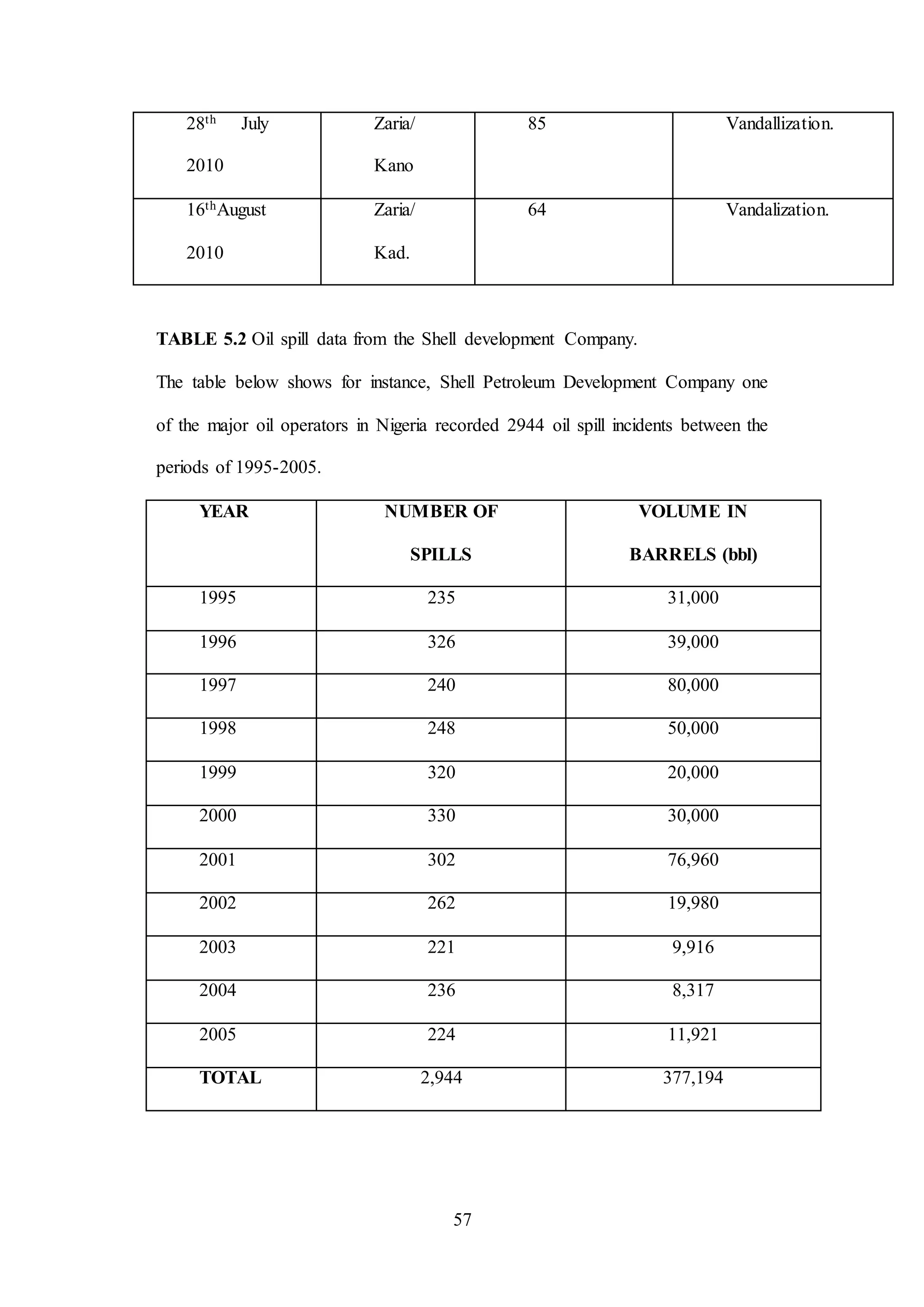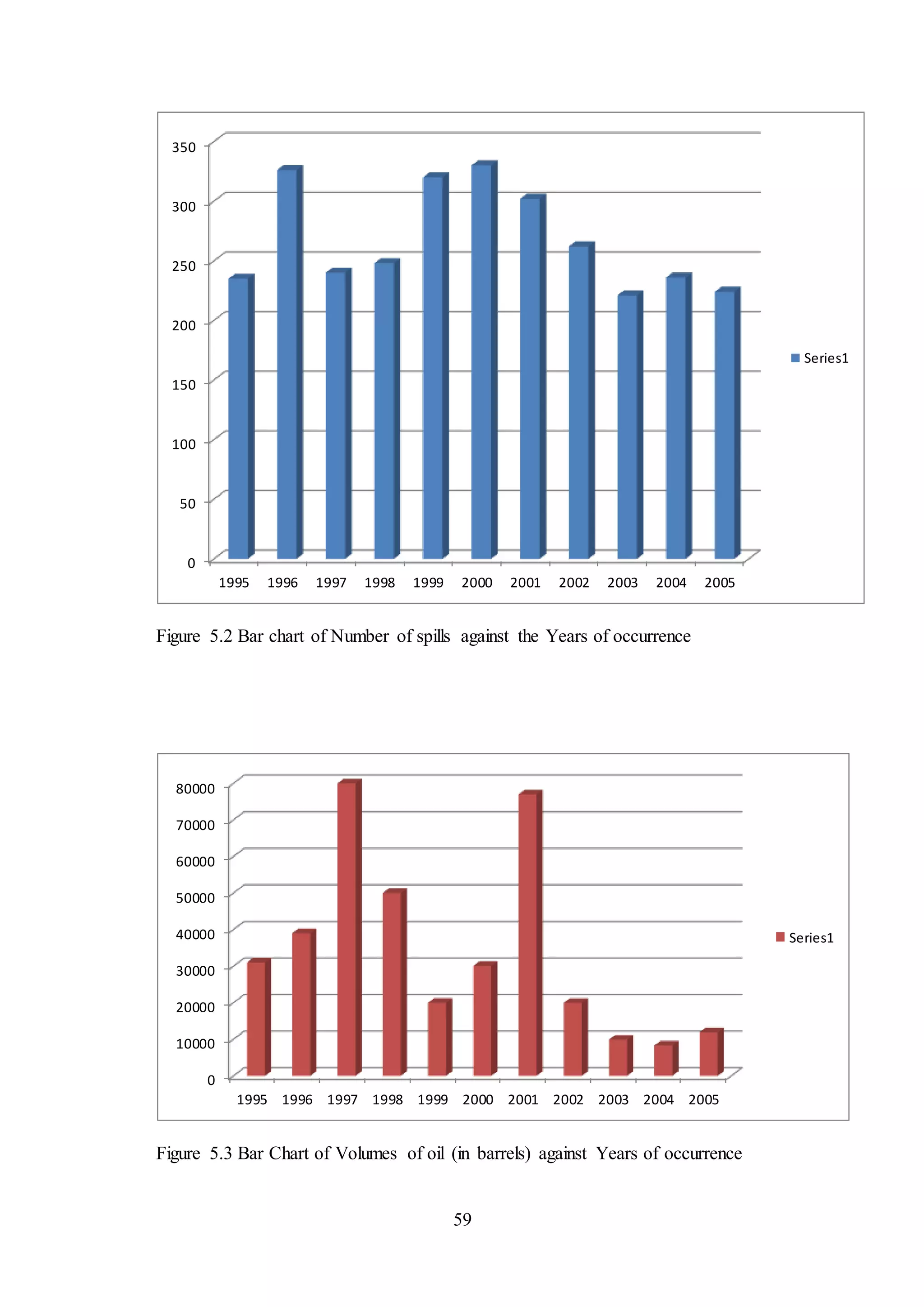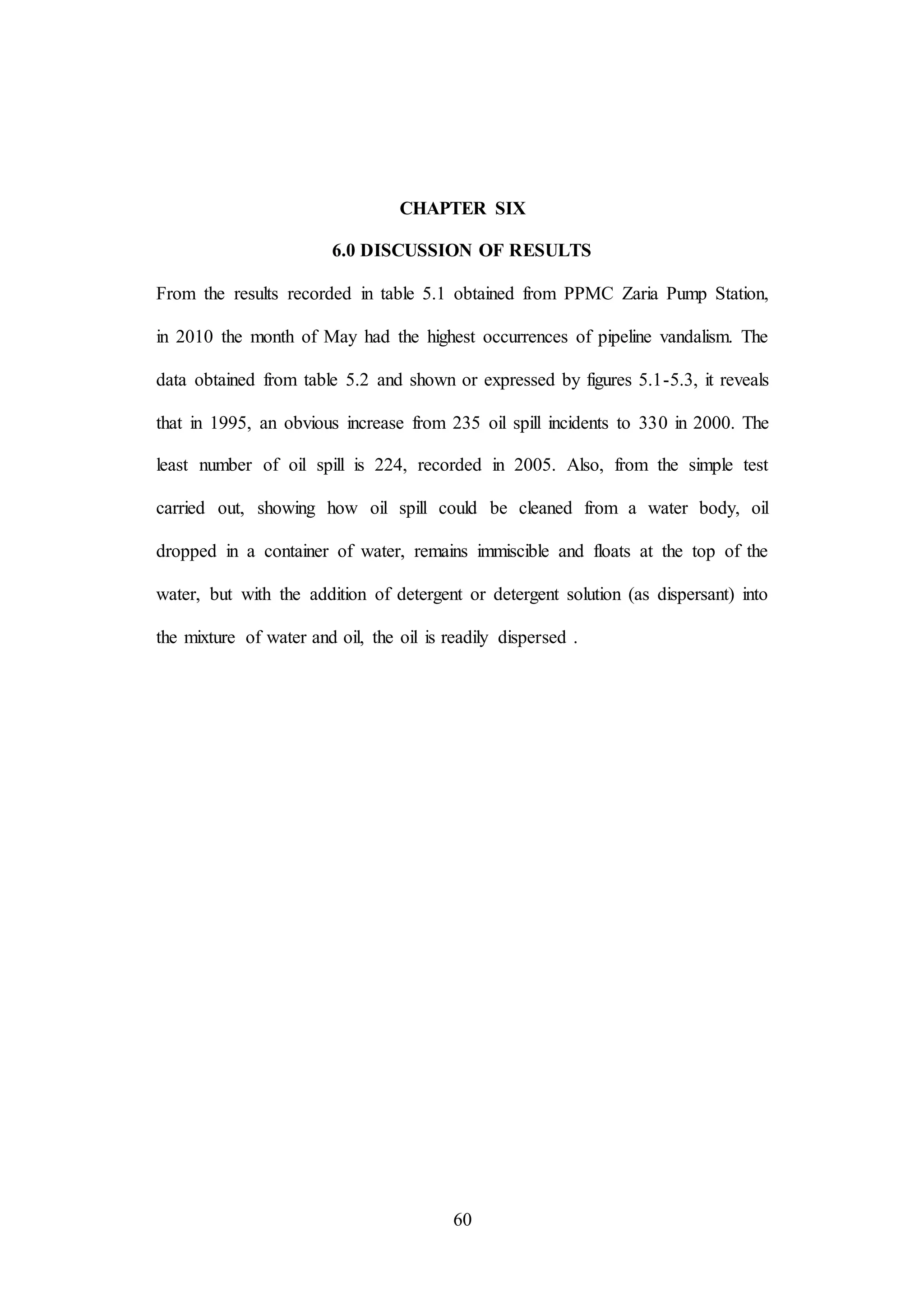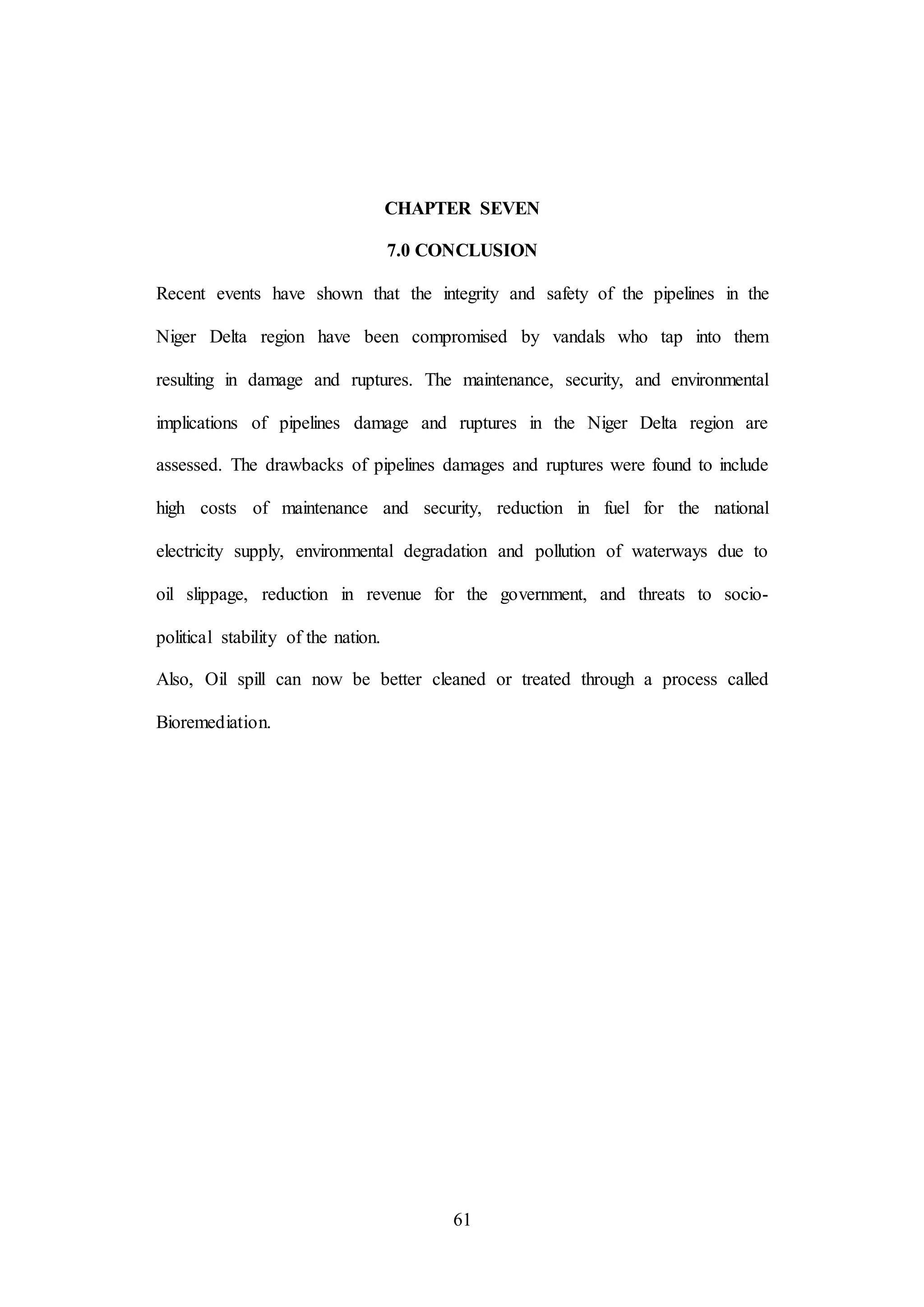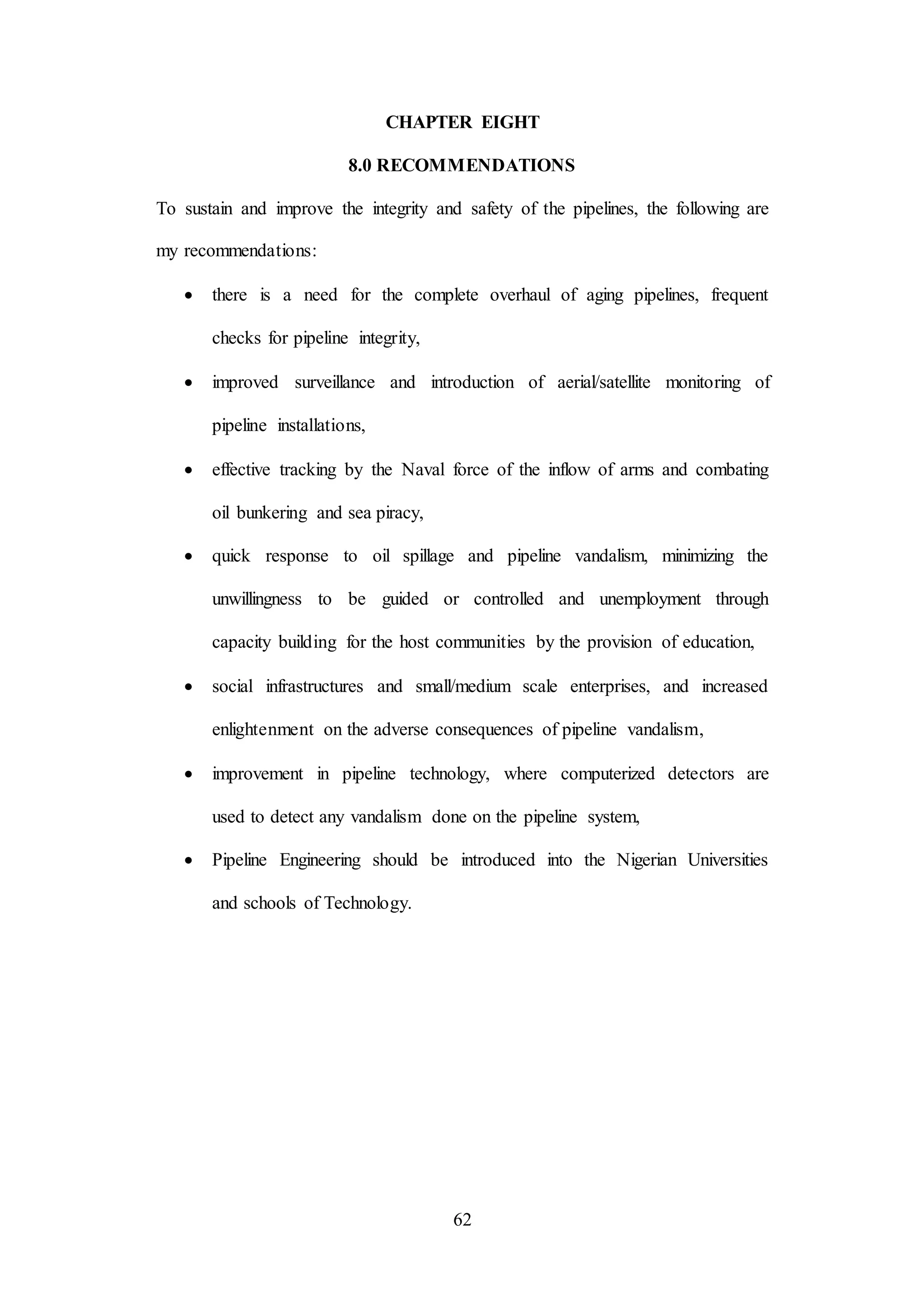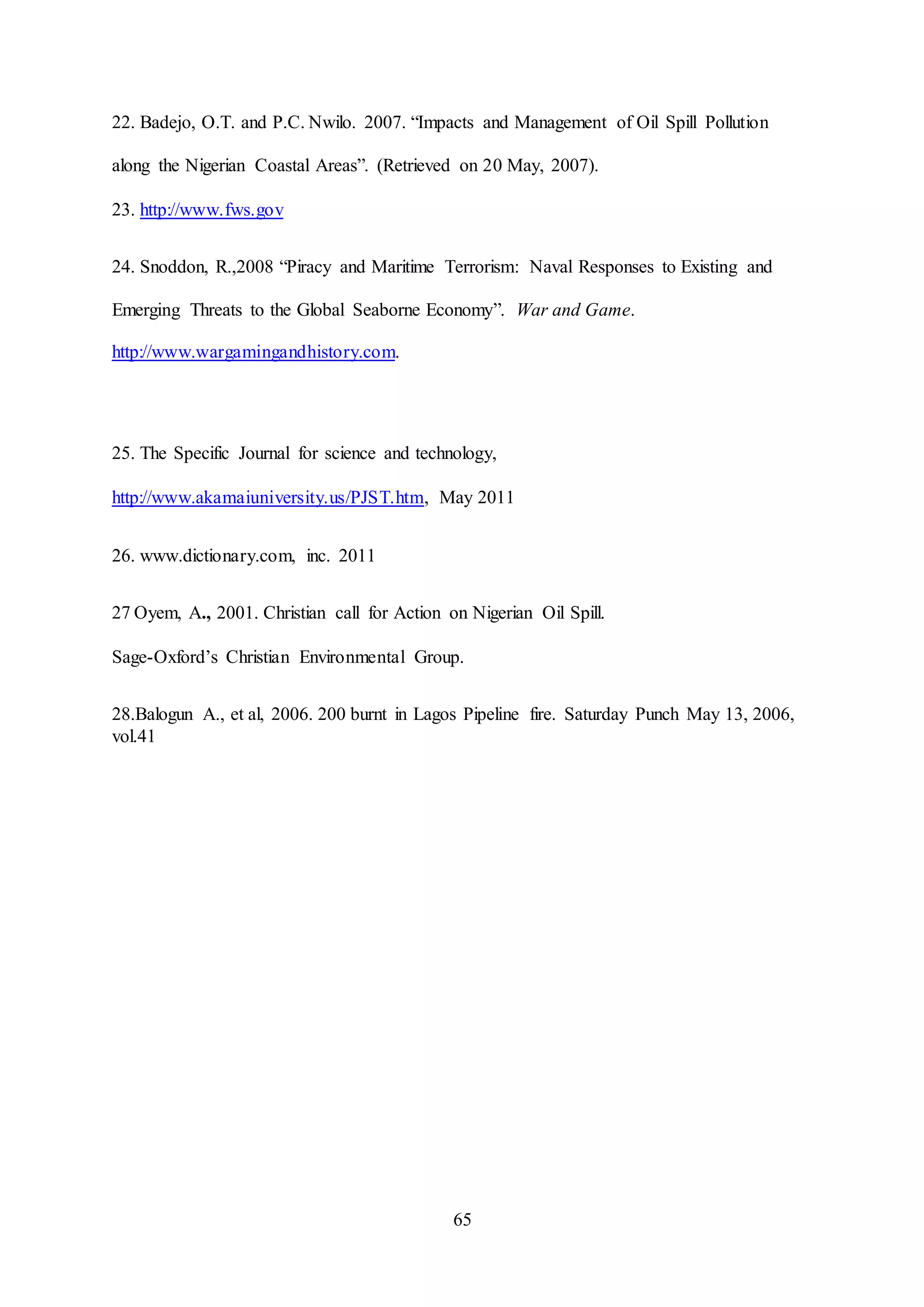This document outlines a research project focused on the combined effects of pipeline vandalism and oil spills in Nigeria, addressing their significant economic and environmental impacts. It emphasizes the need for improved pipeline management, surveillance, and community involvement to mitigate these issues and sustain national security and prosperity. The project serves as a partial fulfillment for a bachelor's degree in chemical engineering at Ahmadu Bello University Zaria.
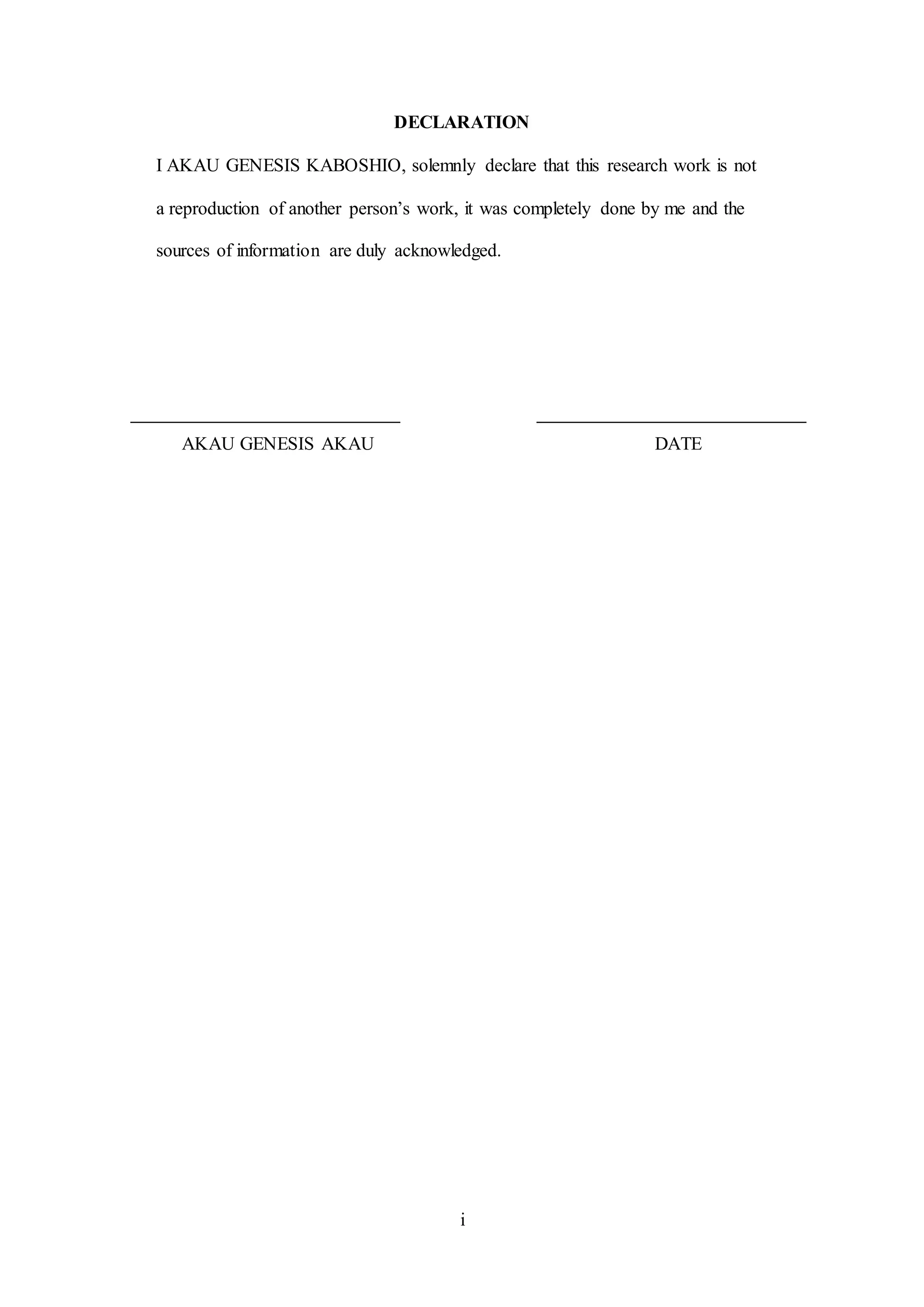
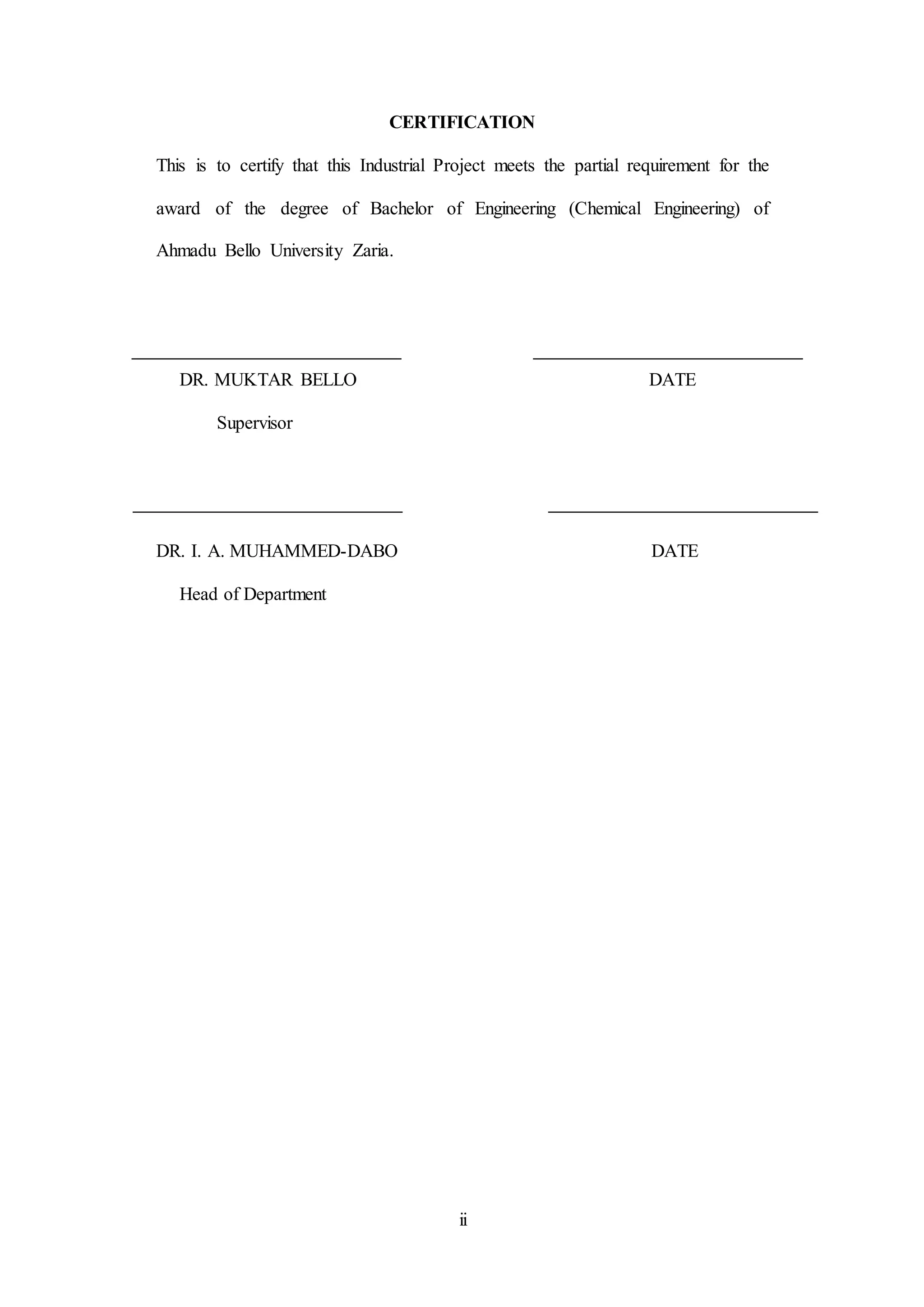

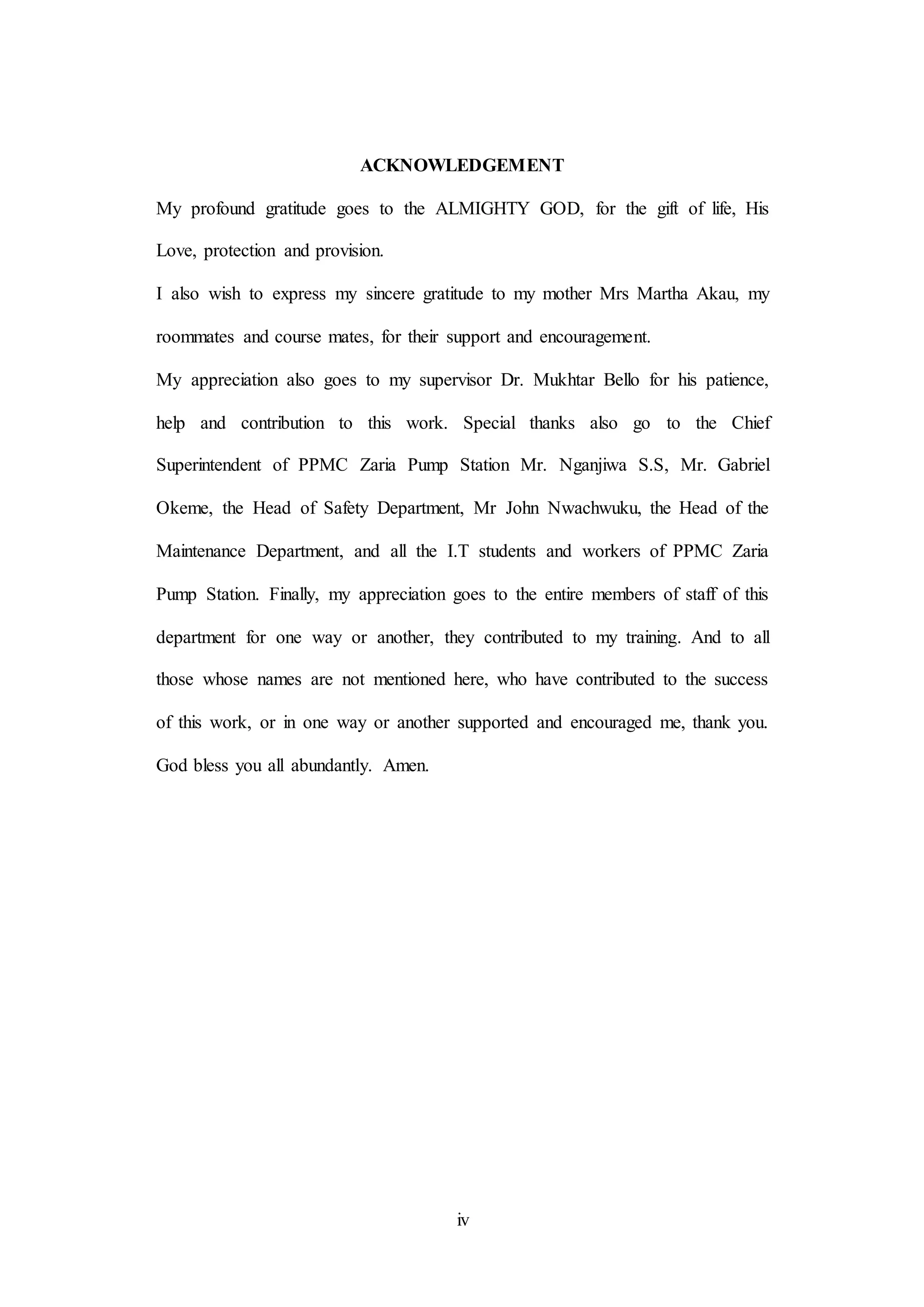
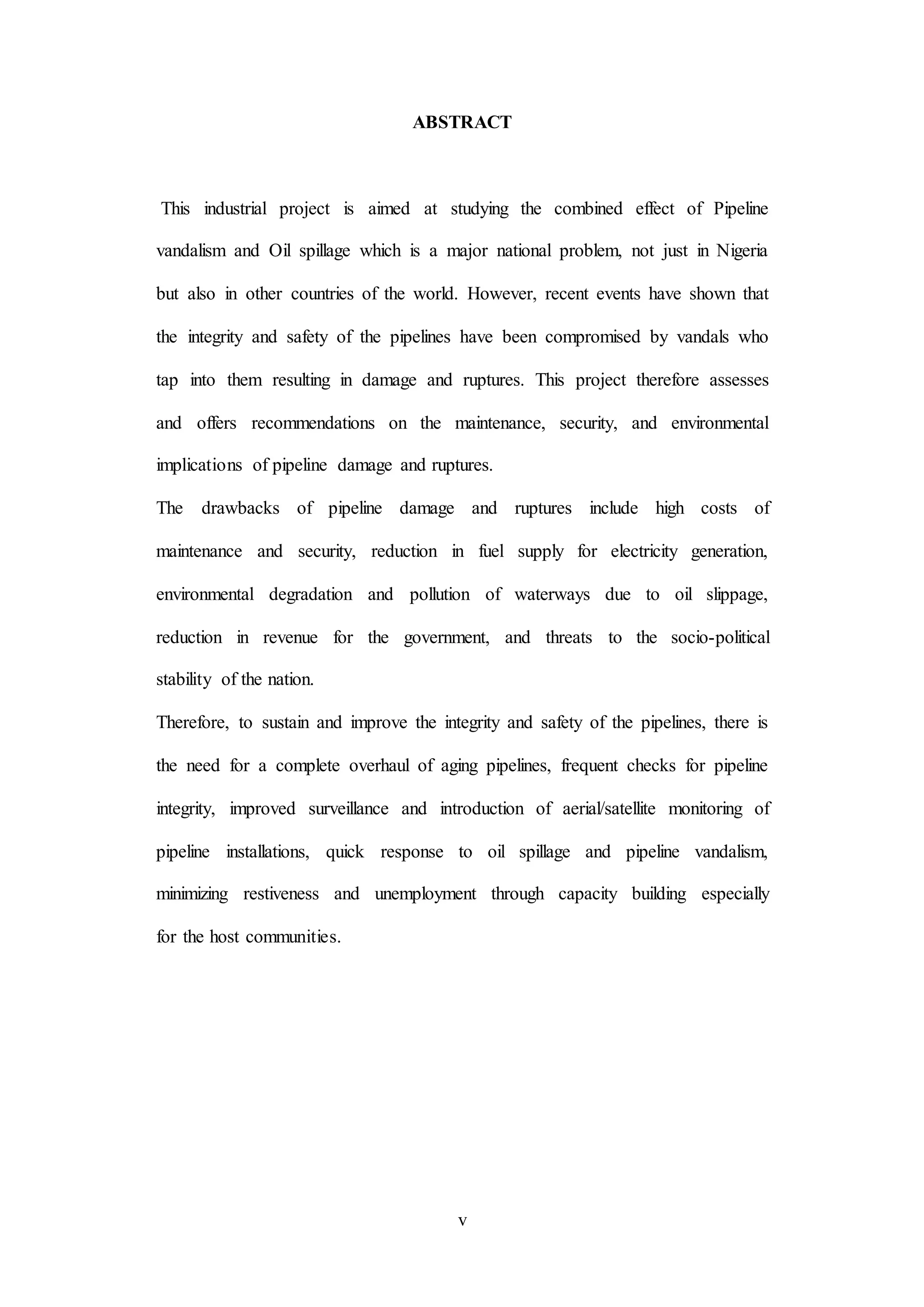

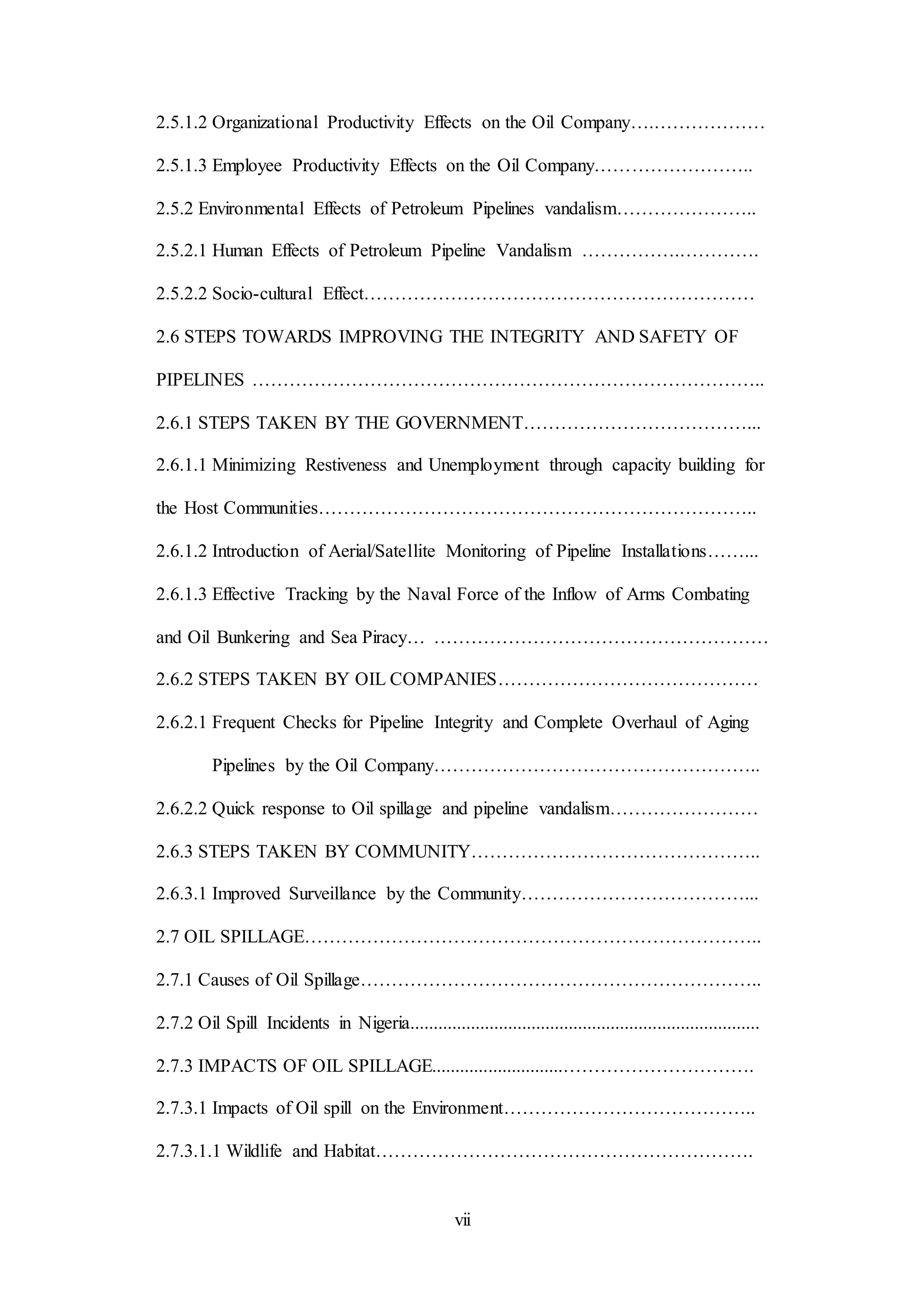

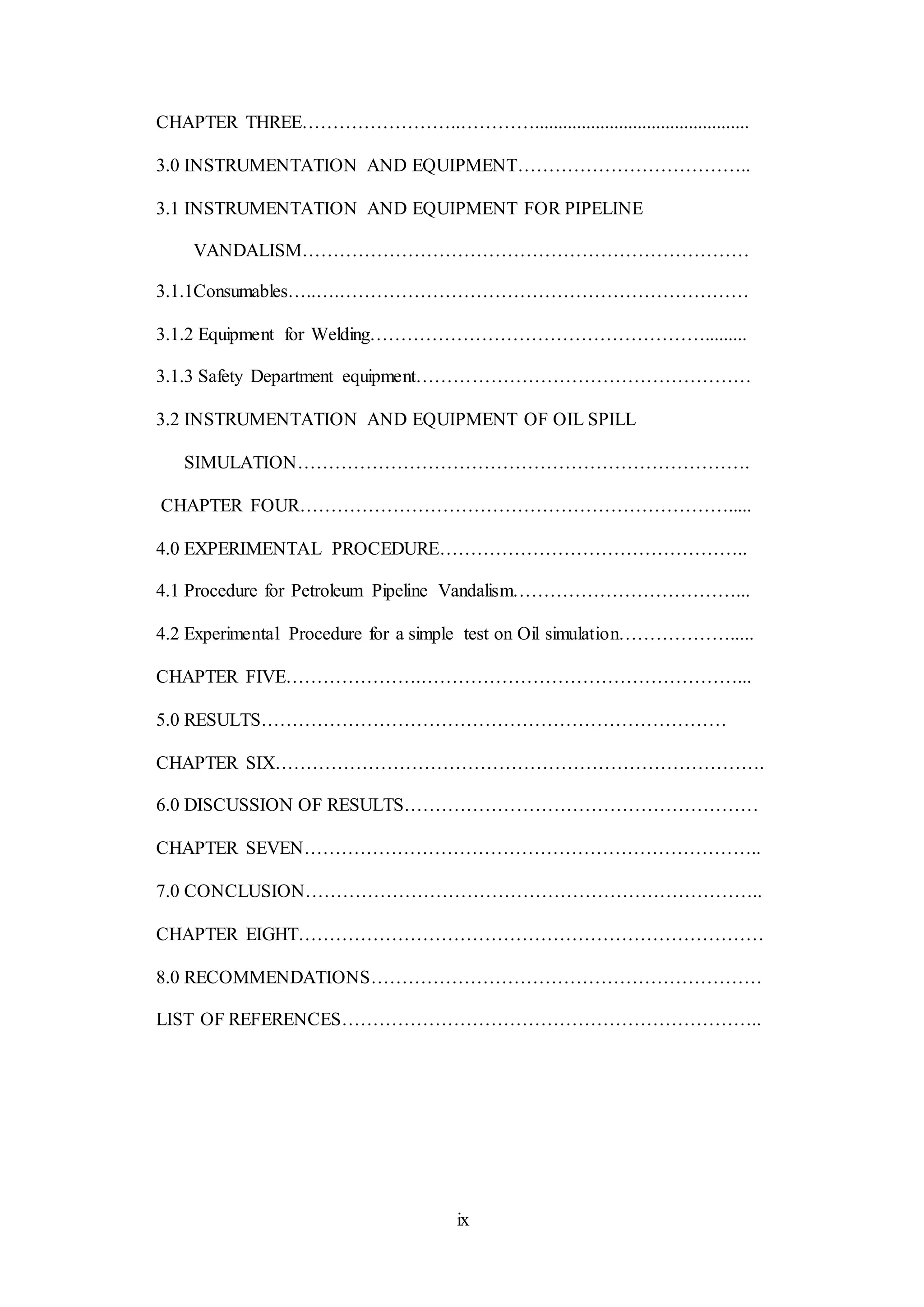

![1
CHAPTER ONE
1.0 INTRODUCTION
Nigeria is not only the most populous country in Africa, with a population
approaching 170 million citizens, but it is African’s largest oil producer, ranking
tenth in the world in oil and gas reserves. Nigeria is a major supplier of petroleum
to the United States and European markets and the sixth biggest exporter in the
world (Global Trade Negotiation web page). The mainstay of Nigeria’s economy
is the Petroleum sector, contributing about 90% of the nation’s foreign exchange
earnings and about 25% of the Gross Domestic Products (GDP). Most of the oil
and gas are produced in the Niger Delta region; a region measuring about 70,000
sq. km in geographical area and lying in the southern-most part of Nigeria [1].
A significant proportion of the Nation’s oil is produced onshore and is
subsequently transported by pipeline; the major means of transporting either the
crude oil, or the refined petroleum products, although recently oil production has
witnessed increased activities in the offshore is through pipeline systems. But due
to the problem of poverty in the nation, and the greed of men, people who are
known to be ‘Vandal’, have devised means of stealing these petroleum products.
This process of theft is called Vandalization.
Vandalization or simply Vandalism is a destructive action, which involves the
malicious and deliberate defacement or destruction of somebody else's property
(according to the Encarta Dictionary). It depicts the destruction of vital national
assets in the communication and energy sectors. Considering vandalization in this](https://image.slidesharecdn.com/genesisi-170318180417/75/Genesis-i-t-project-work-11-2048.jpg)
![2
context, we also see it as a forceful and illegal way of obtaining petroleum
products by creating holes along the transporting pipelines. Over the years, the
amount of oil produced and transported between points of production, processing
and distribution or export terminals has greatly increased as the demand of and
dependence on oil increased.
Although this increase in oil production level contributes to the national
economic growth, it also presents increased potential for environmental pollution
and degradation. Experience has shown that oil spill into the environment holds
negative consequences. Apart from the problem of air pollution and vegetation
loss, there is reduction in the use of aquatic resources and soil degradation. There
are complex and extensive systems of pipelines across the country, which is the
hub of oil exploration and production in Nigeria. It has been observed that
thousands of barrels of oil have been spilled into the environment through oil
pipelines and storage facilities failure in Nigeria. The causes of pipeline damage
and leakage can differ greatly ranging from material defects and pipe corrosion to
ground erosion, tectonic movements on the sea bottom and contact with ship
anchors and bottom trawls particularly in the offshore operations while vandalism
is observed as the substantial cause of pipeline damage onshore in Nigeria [1]
1.1 HISTORICAL BACKGROUND
The Pipelines and Products Marketing Company (P.P.M.C) was set up as a
subsidiary and strategic business unit of the Nigerian National Petroleum
Corporation (NNPC). PPMC is run in conformity with the management culture of
total quality in pursuant to the directive of the parent corporation the Nigerian
National Petroleum Corporation (NNPC).](https://image.slidesharecdn.com/genesisi-170318180417/75/Genesis-i-t-project-work-12-2048.jpg)


![5
CHAPTER TWO
2.0 LITERATURE REVIEW
The Webster dictionary defines a Vandal as “Someone who wantonly or
ignorantly destroys or disfigures natural or human works of beauty. Vandalism is
the wanton destruction or spoiling of what should be preserved”. Therefore,
Vandalism can be defined as an act of wantonly or ignorantly destroying or
disfiguring things aesthetically designed for environmental beauty e.g. street
lights for the protection of lives and property like the bridge railings, pipelines for
the delivery of petroleum products to specific places, transformers and cables for
the distribution and transmission of energy or sound [2].
The utterly immoral activities of vandals have caused pains and death of innocent
citizens and the vandals themselves. It has also led to the disruption of delivery of
social services to the citizenry. Vandalism has become a phenomenon, which
recurs in our daily socio-economic dictionary [3]. Therefore for the purpose of
this project, as we focus on Oil pipeline vandalization which is a criminal act of
destroying oil pipelines, in an attempt to illegally tap oil and other petroleum
products. Before we consider the major causes, effects or implications and
solutions of oil pipeline vandalization, let us briefly look into exploration,
distillation and types of oil.
2.1 OIL EXPLORATION AND EXPLOITATION IN NIGERIA
In 1956, the Royal Dutch Shell (formally Shell British Petroleum) discovered
crude oil at Oloibiri, a village in the Niger Delta, but the commercial production
of the crude oil began in 1958. Today, there are 606 oil fields in the Niger Delta,](https://image.slidesharecdn.com/genesisi-170318180417/75/Genesis-i-t-project-work-15-2048.jpg)
![6
of which 360 are on-shore and 246 off-shores. [4]. Nigeria is now the largest oil
producer in Africa and the sixth largest in the world, averaging 2.7 million barrels
per day (bbl/d) in 2006. The oil sector is the most integral sector to the economy
of Nigeria. It provides 20% of Gross Domestic Product (GDP), 95% of foreign
exchange earnings, and about 65% of budgetary revenues [5].
According to the World Markets Research Center, the combined capacity of
Nigeria's state-held refineries (Port Harcourt I and II, Warri, and Kaduna) is
438,750 bbl/d, the reasons for this are sabotage/vandalism of pipelines, fire
outbreak, poor management and lack of regular or poor maintenance results to a
low unexpected current capacity of around 214,000 bbl/d. Plans for several small,
independently owned refineries are also being developed, with the Nigerian
government planning for three new refineries to come onstream by 2008[6].
2.2 OIL AND GAS RESERVES IN NIGERIA COASTAL AREA
It is estimated Nigeria's proven oil reserved at 35.2 billion barrels [7]. The
Nigerian government plans to expand its proven reserves to 40 billion barrels by
2010. In February 2005, Nigeria announced the award of five oil blocks in the
Joint Development Zone (JDZ), shared by Nigeria and neighboring Sao Tome
and Principe (STP). The JDZ reportedly holds reserves of 11 billion barrels and
could potentially yield up to 3 million bbl per day in the next 2-3 years.
Development is also occurring in the waters surrounding the JDZ. Oil and Gas
Journal (2005) further stated that Nigeria has an estimated 176 trillion cubic feet
(Tcf) of proven natural gas reserves, giving the country one of the top ten natural
gas endowments in the world and the largest endowment in Africa [8].](https://image.slidesharecdn.com/genesisi-170318180417/75/Genesis-i-t-project-work-16-2048.jpg)
![7
2.3 PIPELINE DAMAGES/SABOTAGE
By investigation and experience, it has been known and proven that the
unwholesome acts of vandalism are majorly carried out by [1]:
i. Those who are allegedly angry that so much has been taken from the Niger Delta
without a commensurate return to mitigate the effects of oil exploration and
exploitation activities taking place in the region. This group specializes in
blowing up crude lines to sabotage the production process. For instance in 2004
and 2006, the Chanomi creek pipeline feeding Warri and Kaduna Refineries were
blown up with dynamite (powerful explosives). Until some negotiations and
settlement agreement/dialogue is reached, the youths from the immediate
community will usually deter one another and refuse any intervention. That of
2004 took about one year for the repairs to be completed. Repairs for the blown
pipeline of 2006 started after the oil companies agreed to provide the
communities with some amenities and the involvement in indigenous contractors
in the repair work. It is expected that this vital pipeline will be available for
product transportation in February 2008, for the period of this disruption, the
Government had to rely on massive importation of products to meet local needs.
Recent developments have shown that pipelines vandalism is majorly
masterminded by illegal bunkerers and criminals who have nothing to do with the
genuine agitation of Niger Delta people. The vandalism of the condensate
pipeline along Utorogu-Ughelli axis has greatly hampered the distribution of
products from Shell pipeline to Nigerian gas Company, which in turn has
hampered supply of gas to PHCN for the generation of electricity.
ii. Those who steal crude and finished products from vandalized pipelines. It is
speculated that about 15% of Nigeria’s 2.6 million barrels per day (bpd) which is](https://image.slidesharecdn.com/genesisi-170318180417/75/Genesis-i-t-project-work-17-2048.jpg)
![8
about 390,000 bpd crude, is stolen daily and unquantifiable amount of refined
products are lost daily to this menace. In Nigeria, interfering with oil pipelines
and installations has assumed huge dimensions and a variety of forms. There are
three major identifiable forms namely; oil bunkering, oil pipeline
vandalization/fuel scooping, and oil terrorism. Compared to oil bunkering and
pipeline vandalism, oil terrorism is a new vocabulary introduced by security
analysts and scholar to describe the deliberate attack on pipeline systems in Iraq
and elsewhere in the world by militias, freedom fighters, and insurgents.
2.3.1 OIL BUNKERING
Nigeria’s most profitable illegal private business in the petroleum industry is
oil bunkering. “Bunkering” is a term used to describe the process of filling a ship
with oil (or coal). Illegal oil bunkering is therefore, a less direct word, substituted
for the theft of oil [12], which involves tapping crude oil directly from the
pipelines. Illegal oil bunkering is a dangerous process that persists in the creeks of
the Niger Delta where oil pipelines form a grid. Stealing oil from pipelines in the
creeks involves building a temporary enclosure around a small portion of
underwater pipe, pumping out water from the enclosure, drilling a hole into the
steel casing of the pipe through which the crude passes, and fitting the hole with a
pipe and control valve. The creek water is the allowed to flow back and fill the
enclosure so that the set-up is underwater and therefore hidden from oil company
inspectors [13].
When crude oil is being pumped through the pipelines, sometimes at a pressure of
600 psi, the thieves are able to fill up to a 1,000 metric tonne barge in a matter of](https://image.slidesharecdn.com/genesisi-170318180417/75/Genesis-i-t-project-work-18-2048.jpg)
![9
hours. The barge is then moved offshore to a transport ship and the oil is sold on
the high seas [14]
Oil bunkering was also reported to involve tapping directly into pipelines at a site
removed from oil company facilities, and connect the pipes to barges that are
hidden in small creeks under cover of mangrove forests [12]. It is estimated that
over 10 per cent of the oil exported from Nigeria every year has actually been
bunkered. Oil bunkering is now an activity that does not necessarily require the
assistance of oil company staff to operate equipment at wellheads or allow access
(though there are reports of conspiracy from company staff).
2.3.2 Pipeline Vandalism (Oil Scooping)
In the 1990s, vandals, mainly unemployed youths operating in remote areas and
communities through which oil pipeline pass, punctured the pipes or took
advantage of ruptured or leaking pipes to siphon fuel or other petroleum products
into drums, plastic containers or storage cans for sale on the black market. The
technology employed was quite rudimentary, involving the use of funnels,
drilling tools and plastic hoses to siphon the products. Also, only few cases of
vandalism occurred. For instance, in 1995 there were only 7 reported cases of
vandalism and in the next three years 33, 34, and 57 cases were recorded [15].
Towards the end of the military rule in Nigeria, the vandalism of oil pipelines,
especially the pipelines for premium motor spirit (PMS), came into the limelight.
But in recent times it has assumed an alarming rate, because of the increase in the
frequency of attacks on these pipelines, increased sophistication in the technology
used, and concentration on the three axes that are crucial to petroleum products
distribution in the country [16].](https://image.slidesharecdn.com/genesisi-170318180417/75/Genesis-i-t-project-work-19-2048.jpg)
![10
2.3.3 Oil Terrorism
In Nigeria, oil terrorism includes such acts as the blowing up of oil pipelines,
installations, and platforms with explosives, and the seizure of oil barges, oil
wells, flow stations, support vessels, and other oil facilities in order to prevent the
exploitation and/or distribution of crude oil or its refined products. It also
involves the taking of employees of the oil companies (most especially the top
ranking employees) and also the close relatives of very influential citizens such as
politicians and governmental officials.
The first act of oil terrorism in Nigeria can be traced to December 2005, when the
Movement for the Emancipation of the Niger Delta (MEND) blew up Shell’s
Opobo Pipeline in Delta State [17]. The leader of the Niger Delta People’s
Volunteer Force (who is widely regarded as a leader of the Ijaw nation) Alhaji
Asari Dokubo, after his arrest in September 2005, militant groups in the Delta
region instructed all multinational oil companies to leave the region, as they were
preparing for a war with the Nigerian government. Since then militants in the
region, seeking to control a greater share of the Nation’s oil wealth, have adopted
a terrorist to lessen the quality or effectiveness of the petroleum industries to
export crude oil. By doing so, they hope that the federal government will lose the
substantial revenue needed to support the interconnected series or processes
devised by the government, and so be forced to their political, economic, and
environment demands [18].
Some of the reported cases of the militants‟ attacks include the following [14]:
I. On January 16th, 2005, a major pipeline supplying crude to the Forcados export
terminal was blown up, cutting supplies by about 100,000 barrels per day.](https://image.slidesharecdn.com/genesisi-170318180417/75/Genesis-i-t-project-work-20-2048.jpg)
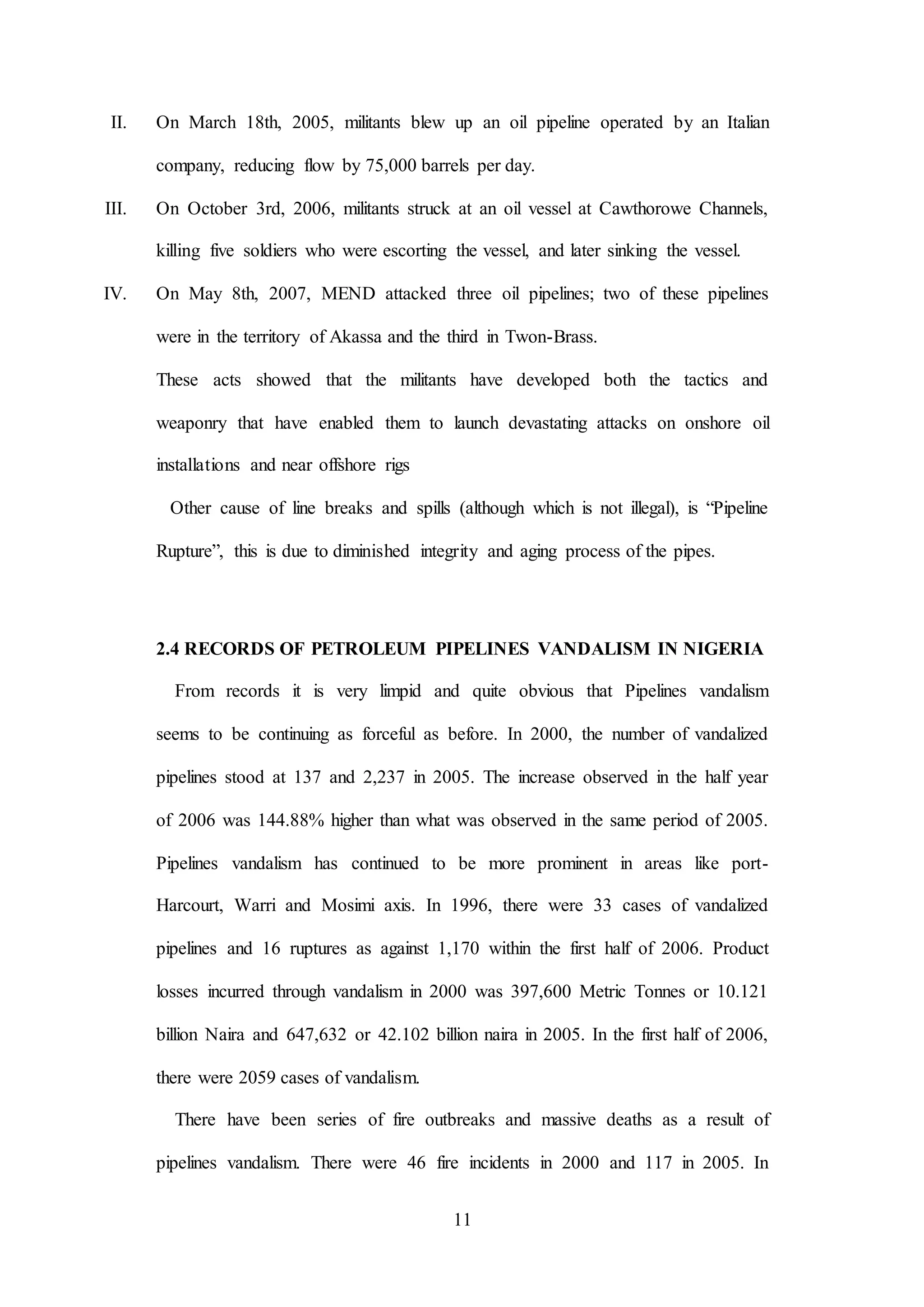
![12
times past, vandalism was predominantly carried out in the south but has taken a
worrisome dimension because it is now carried out all over the country. [15]
2.5 THE EFFECTS OF PETREOLEUM PIPELINE VANDALIZATION
Despite the efforts and awareness campaigns of the government, oil companies,
the communities and some individuals (N.G.Os), aimed at controlling the menace
of petroleum pipeline vandalism, it has remained an incomplete and unsolvable
problem by all the above listed parties. Some of the factors attributable to the
menace are the Niger-Delta struggles for emancipation, unemployment,
corruption and wide spread of poverty. The implications of petroleum pipeline
vandalism are reflected on humans, animals (both terrestrial and aquatic),
economy and the environment.
Below are some of the life threatening conditions that petroleum pipeline
vandalization can cause us all in this our great country Nigeria. For better
comprehension, the effects of oil pipeline vandalization will all be basically
categorised into:
a. Economic effects on both the Government and the Oil Companies; and
b. Environmental effects.
2.5.1 Economic effects of Petroleum Pipeline vandalism on both the
Government and the Oil Company
The protective majors and maintenance done which includes; improving the
integrity and safety of pipelines and the environment by overhauling aging
pipelines, frequently checking pipeline integrity on the pipeline networks,
involves the expenditure of huge capital by both the oil companies and the federal
government (e.g., using cathodic protection devices to monitor steel pipes for](https://image.slidesharecdn.com/genesisi-170318180417/75/Genesis-i-t-project-work-22-2048.jpg)
![13
corrosion) and others. And so, when petroleum pipelines are being vandalized in
whatsoever form, there is an urgent need to properly repair and maintain the
pipeline network regularly and also keep the environment clean from any oil spill.
On the part of the oil companies, the money that could have been spent on other
areas of oil exploration and production are used for the repairs of vandalized
pipelines and cleaning oil spills.
This could be one of the major reasons for the high selling price of petroleum
products in the country. Since most oil companies operate on joint venture
contractual agreements (and of recent production sharing contracts), the Federal
Government also bears part of this burden because of the negative impact the
government to render diverse socio-economical responsibilities to the people. [1]
The following are specific factual records of the effects of oil pipeline vandalism:
[19].
i. Stealing of crude, white products from vandalized and ruptured pipelines, illegal
bunkering and smuggling of petroleum products is causing so much damage to
the country’s economy. Except something is done urgently, we may bequeath to
our future generation a downstream sector that is import dependent and dollar
driven. Nigeria loses billions of naira to these private pockets. In 2000 the loss
was calculated to be N10.121 billion while the losses stood at N42.102 in 2005.
ii. On 3rd June 2002, NNPC shut its crude pipeline from Escravos terminal to Warri
and Kaduna shutting 120,000bpd to Warri and 110,000 bpd to Kaduna
iii. Blowing up Chanomi creek pipeline stopped crude supply to the Warri and
Kaduna Refineries. This only encourages massive importation of petroleum
products causing:](https://image.slidesharecdn.com/genesisi-170318180417/75/Genesis-i-t-project-work-23-2048.jpg)

![15
more from internal than external. And these threats are of different forms with
respect to the country. Oil pipelines and facilities are sensitive strategic assets that
must be protected at all times In terms of strictly national security considerations
seeing their high cost of maintenance and replacement. Oil pipeline vandalism,
regardless of whether it is executed by nationals, foreigners, or terrorist groups, is
a serious threat to national security, particularly for a country that depends
heavily on oil exports for survival. This is essential because in a situation of war
with another country, pipelines are usually one of the first targets of an enemy
and preserving them could be the difference between victory and defeat [20].
Therefore, because of this security problem, it has become the obligation of the
government to spend great amount of finances and material resources on
safeguarding the integrity of the oil pipelines. Given that Nigerian economy
depends on oil exports for survival, oil pipelines and installations are the
networking channels through which Nigeria’s number one economic wealth that
is crude oil and its refined products, are transported to various parts of the
country. It follows that attacks on them, both in peace and war situations, could
suffocate the Nigerian state and render it incapable of defending itself against
internal activities or external aggression. More so, in view of the strategic
position these facilities occupy in the political economy with regards to security
and development in Nigeria, there is no doubt that Nigeria’s oil pipeline network
and facilities still remain vulnerable to both militants and terrorist attacks.
Another major implication of oil pipeline sabotage for national security is the
huge loss of government revenue. Oil pipeline sabotage undermines the capacity
of the government to generate resources needed to fulfil its responsibilities, of
which the security of its citizens is a primary consideration. In February 2007, for](https://image.slidesharecdn.com/genesisi-170318180417/75/Genesis-i-t-project-work-25-2048.jpg)
![16
instance, the NNPC estimated that the nation lost about 10 billion Naira (includes
losses incurred because of damage to equipment and losses of products and
equipment) to pipeline vandalism. [22] Such funds represent lost opportunities for
funding initiatives to provide basic and quality services to citizens, better equip
the security forces to ensure the security of life and property, strengthen
institutions that promote human rights, and undertake infrastructural
development, among others.
In addition, oil pipeline vandalism in the form of illegal bunkering is one of
the factors such as poverty and unemployment that adds to criminality, cult
clashes, communal violence, proliferation of small arms, and political instability
in the region. In Nigeria, the sabotage of pipelines conveying crude oil or gas to
power plants has resulted in power cuts. Reliable electricity supply is critical for
national development, and by extension, national security.
2.5.1.2 Organizational Productivity Effects on the Oil Company
i. Low capacity utilization
ii. Increased cost of production
iii. Downsizing to reduce overhead costs causing Union/Management friction
iv. Decreased productivity
2.5.1.3 Employee Productivity Effects on the Oil Company
i. Increased workplace stressors
ii. Heightened tension, anxiety and fear of retrenchment by workers
iii. Reduced motivation Man hour losses to strikes and lockouts
iv. Decreased productivity.](https://image.slidesharecdn.com/genesisi-170318180417/75/Genesis-i-t-project-work-26-2048.jpg)
![17
2.5.2 Environmental Effects of Petroleum Pipelines vandalism
Degradation of the environment is one of the worst disasters that have befallen
the areas where pipelines have been vandalized. Raging fires have destroyed
farmlands and forests thereby reducing arable land for farming. Spills into
waterways destroy marine and aquatic life, flora, fauna, resort centres, and result
in the pollution of potable water. Pipeline vandalism compounds oil spillages
from other sources and exacerbates the problems of environmental degradation
and pollution of waterways. [23]
Oil spill effects are so alarming that an oil spill is considered to be serious
environmental catastrophe. Annually, millions of gallons of oil are discharged
into the oceans due to careless handling, offshore oil drilling, and terrorist
activities. In addition to having disastrous effects on the environment, an oil spill
is often deadly or harmful to wildlife. Short term oil spill effects include tarred
coastlines and seashores, dead or injured plants and animals (especially aquatic),
and contaminated water. With the passage of time, the surrounding ecosystem
could be endangered and even ultimately destroyed, if oil spills that are not
cleaned.
Leakage of oil into a body of water, like a river or stream, has very unpleasant
complicating results. The surface of the water becomes coated with very thick
layers of crude oil, preventing oxygen from getting to the fish and other marine
life in the water. Also, aquatic wildlife and their habitats are affected by oil spills
by means of physical contact, ingestion, absorption, and inhalation. The oil spill
causes damage to the entire aquatic food chain. Plankton, algae, larvae, and fish
eggs which are consumed by small fish species are contaminated. This
contamination is then passed on to larger fish, aquatic birds, and even humans.](https://image.slidesharecdn.com/genesisi-170318180417/75/Genesis-i-t-project-work-27-2048.jpg)
![18
The growth and germination of marine plants are affected by oil spills as well.
The source of all these problems is due to the effects of petroleum pipeline
vandalization.
2.5.2.1 Human Effects of Petroleum Pipeline Vandalism
Oil pipeline vandalism also affects humans which is the most critical, because
other subjects of the Oil pipeline Vandalism could be replaced or guarded, but for
the human life, it is a different case entirely.
The following are lists of how humans are affected by oil pipeline vandalism.
[19]
i. Lack of portable drinking water
ii. Depleted arable land for farming
iii. Polluted water, endangering aquatic life and loss of income through fishing
iv. Increased poverty
v. Hidden health costs
vi. Downsizing of employees involved in the chain of oil production thereby
increasing the incidence of unemployment
vii. Loss of lives through explosions while scooping fuel from vandalized pipelines
October 1998, more than 1,000 persons died in an explosion in Jesse, Delta State.
March 2000, more than 50 persons died in Osisioma Local Government Area of
Abia State
July 16, 2000, more than 100 persons died in Warri area
November 30, 2000; about 60 persons died from explosions in Ebute
2001, more than 500 persons died in Atlas Cove Takwa Bay explosions
June 2003, over 200 persons died in OnichaAmiyi-Uhura, Isikwuato Local
government area of Abia State](https://image.slidesharecdn.com/genesisi-170318180417/75/Genesis-i-t-project-work-28-2048.jpg)
![19
September 17, 2004 more than 50 persons died from explosions in Lagos area
December 21, 2005 five persons died at Ehor
May 2006, a gasoline pipeline explosion killed about 200 persons at Inagbe in the
eastern part of Lagos
Other effects, caused by the petroleum pipeline vandalism are given below.
2.5.2.2 Socio-cultural Effects.
i. Inter-intra tribal and inter communal strife
ii. Increased crime rate and insecurity
iii. The erosion of values and traditions
iv. Collapse of communal life
Aside the above given effects of Oil pipeline vandalism, there are factors that
exacerbate these effects. In other words, these factors make the already
problematic effects worse. They are:
a. Poverty Corruption
b. Underdevelopment
c. Unemployment
d. Collision of security agents and elites
e. Smuggling. [19]
2.6 STEPS TOWARDS IMPROVING THE INTEGRITY AND SAFETY OF
PIPELINES
In order to improve the integrity and safety of Oil pipelines, the steps taken
involves the combine contribution of the Oil companies, Government,
Communities and Non-Governmental Organizations (N.G.Os) of which they form](https://image.slidesharecdn.com/genesisi-170318180417/75/Genesis-i-t-project-work-29-2048.jpg)


![22
firms have the very best software applications and upgrade modules to perform
the best pipeline inspections.
2.6.1.3 Effective Tracking by the Naval Force of the Inflow of Arms and
Combating Oil Bunkering and Sea Piracy
Despite the advances in global maritime security, attacks by pirates have been on
the increase. Reported maritime terrorist attacks are rare by comparison, although
they may well be contributing to the increase in piracy. A maritime attack on the
Northern Arabian Gulf Oil Terminal (NAGOT) in April 2004 was thwarted
because of the vigilance of U.S. Naval and Coast Guard units monitoring vessel
traffic in the restricted areas surrounding the facility [24].
In the Niger Delta, sea piracy has become a major threat and creates fear among
travelers along the various waterways that cascade the region. Vessels are equally
not spared, as most often the unescorted ones are hijacked; the items therein are
vandalized and at times ran aground. The situation is further compounded by the
terrain and thousands of creeks, which not only makes effective policing difficult
but also provides safe havens for the criminals. Therefore, to effectively track the
inflow of arms and combat oil bunkering and sea piracy in the Niger Delta region,
the Federal Government must equip the Nigeria Navy and make them battle ready
for the security of the coastline.
2.6.2 Steps taken by the Oil Company
Aside the Government’s efforts to enhance the improvement and safety of the oil
pipelines in Nigeria, the Oil companies which are the major beneficiaries of the
profit made from the exploration and exploitation of the crude oil and the refined
products and also on the receiving side of some losses made and effects of the oil](https://image.slidesharecdn.com/genesisi-170318180417/75/Genesis-i-t-project-work-32-2048.jpg)


![25
b) listing of jobs to be done in order of priority, organizing a communication
network to coordinate response and identify probable oil movement patterns
under different weather conditions, assessing information sensitive maps and
compiling other technical data, and
c) Knowing important physical and biological resources within or near the region
such as marshes and vital habitat areas required by particular species for
spawning, feeding or migrating, and gathering information about tides, currents
and local climate conditions, weather patterns and shoreline characteristics. [25]
2.6.3 Step taken by the Community
The communities where the oil exploration and exploitation of the crude oil and
refined petroleum products takes place receive some dividends and also they are
more prone to the effects caused by oil pipeline vandalization. They also, just like
the Government and the Oil Companies have their role to play in the
improvement and safety of the oil pipelines which is stated below.
2.6.3.1 Improved Surveillance by the Community
There should be an improved surveillance and introduction of aerial/satellite
monitoring of pipeline installations to prevent and control pipeline vandalism by
responding quickly to any act of oil bunkering, pipeline vandalism/oil scooping
and oil terrorism. Security agencies in collaboration with youth and community
leaders should be deployed to patrol oil and gas pipeline right of way, although it
is sad that some of these security men and trusted allies are also working in
consonance with the vandals.](https://image.slidesharecdn.com/genesisi-170318180417/75/Genesis-i-t-project-work-35-2048.jpg)
![26
2.7 OIL SPILLAGE
Oil Spill is an accidental release of oil into a body of water, as from a tanker,
offshore drilling ring, or underwater pipeline, often presenting a hazard to marine
life, the land around the area of spill and environment. [26]
Oil spill incidence through vandalism in Nigeria appears to be peculiar and has
been very much frequent in recent times, looking at the data given above from
past records, and if no urgent measure and strategies are placed to curtail this
problematic issue by the relevant Nigerian agencies, then the frequent pipeline
cuts that continue to spill out crude oil or petroleum products for days, weeks and
months has the ability to gradually weaken or diminish the obligated efforts of
government in the management of the spill. Oil pipeline vandalism and disruption
of oil production activities are presently the unfortunate integral part of oil and
gas operations in Nigeria.
Pipeline vandalism compounds oil spillages from other sources and exacerbates
the problems of environmental degradation and pollution of waterways [25]. Oil
spill effects are so alarming that an oil spill is considered to be serious
environmental catastrophe. Annually, millions of gallons of oil are discharged
into the oceans due to careless handling, offshore oil drilling, and terrorist
activities. In addition to having disastrous effects on the environment, an oil spill
is often lethal to wildlife. Short term oil spill effects include tarred coastlines and
seashores, dead or injured flora and fauna, and contaminated water. With the
passage of time, oil spills that are not cleaned can ultimately destroy the
surrounding ecosystem. [1]](https://image.slidesharecdn.com/genesisi-170318180417/75/Genesis-i-t-project-work-36-2048.jpg)
![27
Before we move on to the causes, effects and other details of oil spill, it is very
essential that we look into a few details about oil or petroleum that we are dealing
with such as: the types of oil and the refining of crude oil.
2.7.1 Causes of Oil Spillage
In Nigeria, fifty percent (50%) of oil spills is due to corrosion, twenty eight
percent (28%) to sabotage and twenty one percent (21%) to oil production
operations. One percent (1%) of oil spills is due to engineering drills, inability to
effectively control oil wells, failure of machines, and inadequate care in loading
and unloading oil vessels. Thousands of barrels of oil have been let loose into the
environment through our oil pipelines and tanks in the country. This loss is as a
result of our lack of regular maintenance of the pipelines and storage tanks. Most
pipelines from the flow stations are obsolete. By international standards, oil pipes
ought to be replaced after 15 to 20 years, but most pipelines in use are 20 to 25
years old, making them subject to corrosion and leakage. Some of these pipes are
laid above ground level without adequate surveillance, exposing them to wear and
tear and other dangers. [27]
About 40,000 barrels of oil spilled into the environment through the offshore
pipeline in Idoho. Sabotage is another major cause of oil spillage in the country.
Some of the citizens of this country in collaboration with people from other
countries engage in oil bunkering. They damage and destroy oil pipelines in their
effort to steal oil from them. Pirates are stealing Nigeria's crude oil at a
phenomenal rate, funneling nearly 300,000 barrels per day from our oil and
selling it illegally on the international trade market. Illegal fuel siphoning as a
result of the thriving black market for fuel products has increased the number of](https://image.slidesharecdn.com/genesisi-170318180417/75/Genesis-i-t-project-work-37-2048.jpg)
![28
oil pipeline explosions in recent years. In July 2000, a pipeline explosion outside
the city of Warri caused the death of 250 people. An explosion in Lagos in
December 2000 killed at least 60 people. The NNPC reported800 cases of
pipeline vandalization from January through October2000. In January 2001, the
Nigeria lost about $4 billion in oil revenues in 2000 due to the activities of
vandals on our oil installations. Nigeria lost about N7.7 billion in 2002 as a result
of vandalization of pipelines carrying petroleum products. The amount, according
to the PPMC, a subsidiary of NNPC, represents the estimated value of the
products lost in the process.
The Nigerian government and oil companies say up to 15 percent of the country's
two million barrels per day oil production is taken illegally taken from pipelines
in the Niger Delta and smuggled abroad. According to Johnson (2004), the
pipeline explosion has killed hundreds of looters and bystanders. The most recent
of the pipeline explosion in Illadu, Lagos May,2006 led to the incineration of
more than 200 people in the pipeline fire [28]. Several deaths recorded from
pipeline fire in recent time are a few of the horrendous effects of crude oil theft
from oil pipeline, a leading cause of oil spill in Nigeria today.
2.7.2 Oil Spill Incidents in Nigeria
Oil spill incidents have occurred in various parts and at different times along
our coast. Some major spills in the coastal zone are the GOCON’s Escravos spill
in 1978 of about 300,000 barrels, SPDC’s Forcados Terminal tank failure in 1978
of about 580,000 barrels and Texaco Funiwa-5 blowout in 1980 of about 400,000
barrels. Other oil spill incidents are those of the Abudu pipe line in 1982 of about
18,818 barrels. The Jesse Fire Incident which claimed about a thousand lives and](https://image.slidesharecdn.com/genesisi-170318180417/75/Genesis-i-t-project-work-38-2048.jpg)
![29
the Idoho Oil Spill of January 1998, of about 40,000 barrels. The most publicized
of all oil spills in Nigeria occurred on January 17 1980 when a total of 37.0
million litres of crude oil got spilled into the environment. This spill occurred as a
result of a blow out at Funiwa 5 offshore station. Nigeria's largest spill was an
offshore well-blow out in January 1980 when an estimated 200,000 barrels of oil
(8.4million US gallons) spilled into the Atlantic Ocean from an oil industry
facility and that damaged 340 hectares of mangrove [28].
According to the Department of Petroleum Resources (DPR), between 1976
and 1996 a total of 4647 incidents resulted in the spill of approximately 2,369,470
barrels of oil into the environment. Of this quantity, an estimated 1,820,410.5
barrels (77%) were lost to the environment. A total of 549,060 barrels of oil
representing 23.17% of the total oil spilt into the environment was recovered. The
heaviest recorded spill so far occurred in 1979 and 1980 with a net volume of
694,117.13 barrels and 600,511.02 barrels respectively. Available records for the
period of 1976 to 1996 indicate that approximately 6%, 25%, and 69%
respectively, of total oil spilled in the Niger Delta area, were in land, swamp and
offshore environments. Also, between 1997 and 2001, Nigeria recorded a total
number of 2,097 oil spill incidents. [28]
Thousands of barrels of oil have been spilt into the environment through our
oil pipelines and tanks in the country. This spillage is as a result of our lack of
regular maintenance of the pipelines and storage tanks. Some of these facilities
have been in use for decades without replacement. About 40,000 barrels of oil
spilled into the environment through the offshore pipeline in Idoho. Sabotage is
another major cause of oil spillage in the country. Some of the citizens of this
country in collaboration with people from other countries engage in oil](https://image.slidesharecdn.com/genesisi-170318180417/75/Genesis-i-t-project-work-39-2048.jpg)
![30
bunkering. They damage and destroy oil pipelines in their effort to steal oil from
them. SPDC claimed in 1996 that sabotage accounted for more than 60 percent of
all oil spilled at its facilities in Nigeria, stating that the percentage has increased
over the years both because the number of sabotage incidents has increased and
because spills due to corrosion have decreased with programs to replace oil
pipelines [30].
Pirates are stealing Nigeria's crude oil at a phenomenal rate, funneling nearly
300,000 barrels per day from our oil and selling it illegally on the international
trade market. Nigeria lost about N7.7 billion in 2002 as a result of vandalization
of pipelines carrying petroleum products. The amount, according to the PPMC, a
subsidiary of NNPC, represents the estimated value of the products lost in the
process. Illegal fuel siphoning as a result of the thriving black market for fuel
products has increased the number of oil pipeline explosions in recent years. In
July 2000, a pipeline explosion outside the city of Warri caused the death of 250
people. An explosion in Lagos in December 2000 killed at least 60 people. The
NNPC reported 800 cases of pipeline vandalization from January through
October 2000. In January 2001, Nigeria lost about $4 billion in oil revenues in
2000 due to the activities of vandals on our oil installations. The government
estimates that as much as 300,000 bbl/d of Nigerian crude is illegally bunkered
(freighted) out of the country.
In Nigeria, fifty percent (50%) of oil spills is due to corrosion, twenty eight
percent (28%) to sabotage and twenty one percent (21%) to oil production
operations. One percent (1%) of oil spills is due to engineering drills, inability to
effectively control oil wells, failure of machines, and inadequate care in loading
and unloading oil vessels.](https://image.slidesharecdn.com/genesisi-170318180417/75/Genesis-i-t-project-work-40-2048.jpg)
![31
2.7.3 IMPACTS OF OIL SPILLAGE
Ever since the discovery of oil in Nigeria in the 1950s, the Country has been
suffering the negative environmental consequences of oil development. The
growth of the country's oil industry, combined with an intense population growth
and a lack of environmental regulations on the magnitude of crude oil pollution
and damage occasioned by Multi-National Oil Companies operations, has led to
the substantial damage of the Nigeria's environment, especially in the Niger Delta
region, the center of the country's oil industry.
Oil spills pose a major threat to the environment in Nigeria. If not checked or
effectively managed, they could lead to total destruction of the ecosystem,
especially in the Niger Delta where oil spills have become prevalent. Life in this
region I increasingly becoming unbearable due to the ugly effects of oil spill, and
many communities continue to groan under the degrading impact of spills [27].
Oil spills often result in both immediate and long-term environmental damage.
Some of the environmental damage caused by an oil spill can last for decades
after the spill occurs. The following are specific areas that oil spillage impacts or
affects negatively. They are:
2.7.3.1 Impacts of Oil spill on the Environment
The environment consists of all the external factors influencing the life and
activities of people, plants, and animals, and it is also referred to as the natural
world, when it is regarded as being at risk from the harmful influences of human
activities [31]](https://image.slidesharecdn.com/genesisi-170318180417/75/Genesis-i-t-project-work-41-2048.jpg)
![32
Therefore, anything that affects the environment (negative or positive), affects all
that the environment influences. The following are the effects of oil spill on the
environment:
Figure 2.2 Sea birds affected by the Exxon Valdez oil spill. [32]
2.7.3.1.1 Wildlife and Habitat
We have all seen pictures and videos of wildlife covered in black, sticky oil after
an oil spill. These pictures are usually of oiled birds. Many people are not aware
that it is not just birds that get oiled during a spill. Other marine life such as
marine mammals can also suffer from the effects of an oil spill. Even small spills
can severely affect marine wildlife.](https://image.slidesharecdn.com/genesisi-170318180417/75/Genesis-i-t-project-work-42-2048.jpg)


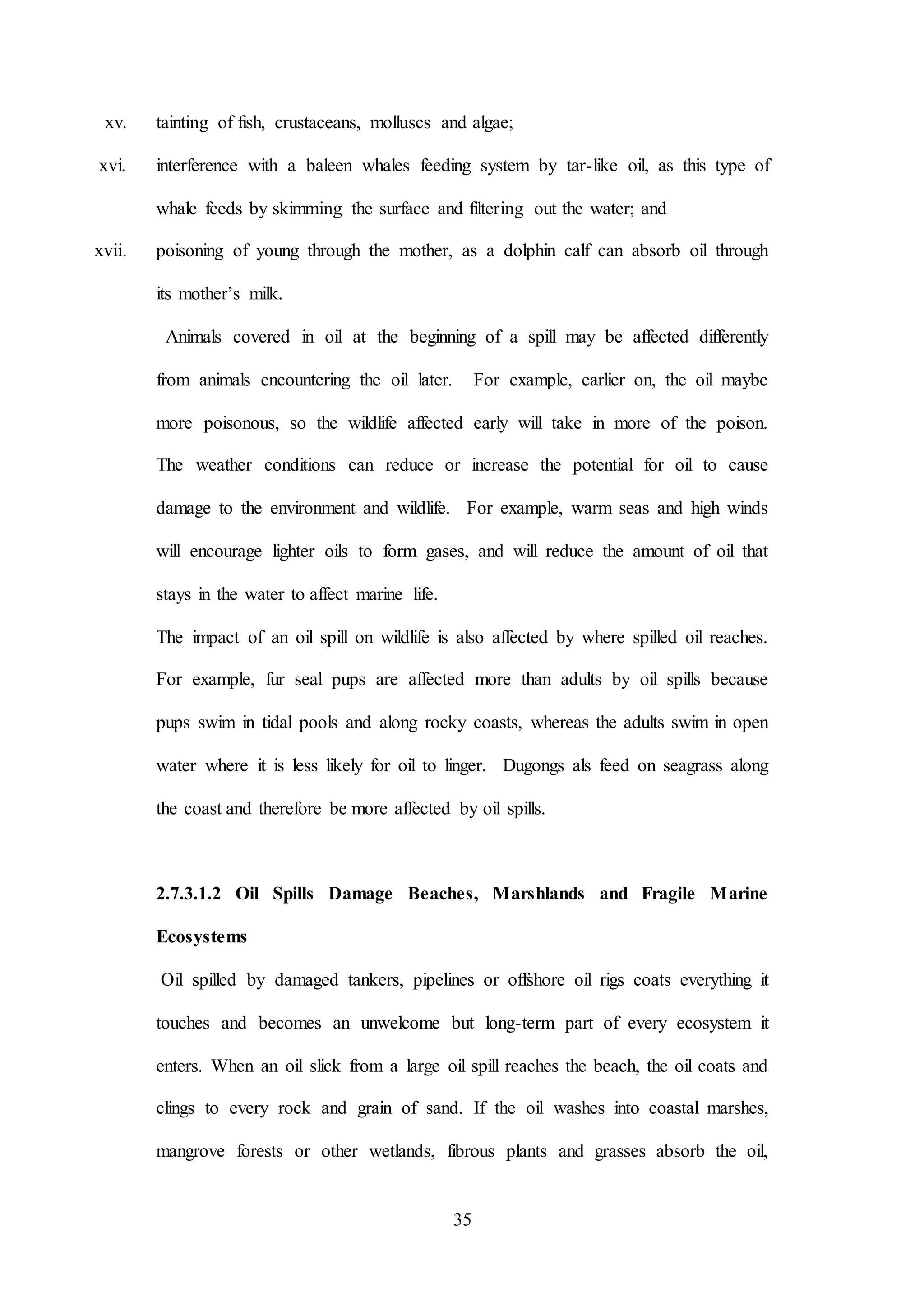
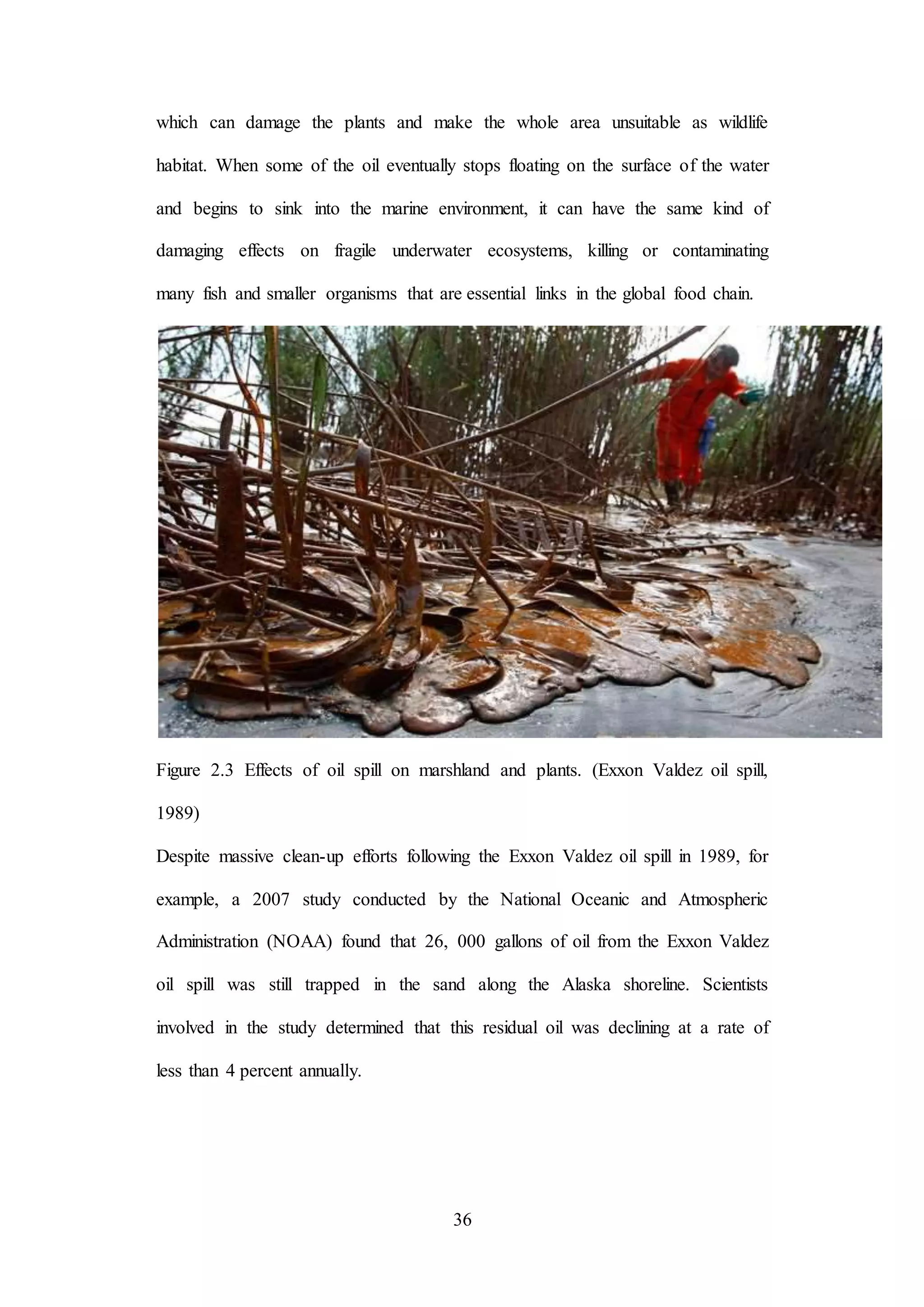



![40
The following are laws and contributions of the Government provided for the
management of oil spill in Nigeria:
2.8.1.1 Oil Pollution Act (OPA) of 1990
The Oil Pollution Act of 1990 (OPA 1990) is responsible for many of the nation's
improvements in oil spill prevention and response. OPA 1990 provides guidance
for government and industry on oil spill prevention, mitigation, cleanup and
liability. The majority of OPA 1990 provisions were targeted at reducing the
number of spills followed by reducing the quantity of oil spilled. OPA 1990 also
created a comprehensive scheme to ensure that sufficient financial resources are
available to clean up a spill and to compensate persons damaged by a spill. It also
ensures that the federal response system is adequately prepared to manage the
impacts of oil spills that do occur; and mandates that industry implement
prevention and preparedness measures. The OPA also mandates that tankers and
inland oil facilities develop individual response plans. Furthermore the OPA also
mandates enhancements to the national response system, and development of
Area Contingency Plans.
2.8.1.2 National Oil Spill Detection and Response Agency (NOSDRA)
A National Oil Spill Detection and Response Agency (NOSDRA) have been
approved by the Federal Executive Council of Nigeria. The Ministry of
Environment, which initiated the Agency, has also forwarded to the Federal
Executive Council for approval, there viewed draft National Oil Spill
Contingency Plan (NOSCP) which the Agency would manage [34].](https://image.slidesharecdn.com/genesisi-170318180417/75/Genesis-i-t-project-work-50-2048.jpg)
![41
The establishment of the contingency plan and the agency was in compliance
with the International Convention on Oil Pollution Preparedness, Response and
Co-operation (OPRC90) to which Nigeria is a signatory. The draft bill on the
NOSDRA has been forwarded to the National Assembly for deliberation and
enactment into law. [34]
Apart from intensifying efforts towards compliance monitoring and enforcement
of oil and gas regulations and standards, the ministry is also mounting pressure on
the oil and gas operators for a gas flare-out. Effort is also being made, according
to the sources, to ensure the use of environmental-friendly drilling fluid and mud
systems. [34]
2.8.1.4 Petroleum Related Laws and Regulations
Part of the means of managing the environment is to have in place the necessary
laws, regulations and guidelines. According to the Federal Environmental
Protection Agency, Lagos Nigeria, the following relevant national laws and
international agreements are in effect: [1]
a. Endangered Species Decree Cap 108 LFN 1990.
b. Federal Environmental protection Agency Act Cap 131 LFN 1990.
c. Harmful Waste Cap 165 LFN 1990.
d. Petroleum (Drilling and Production) Regulations, 1969.
e. Mineral Oil (Safety) Regulations, 1963.
f. International Convention on the Establishment of an International Fund for
Compensation for Oil Pollution Damage, 1971
g. Convention on the Prevention of Marine pollution Damage, 1972](https://image.slidesharecdn.com/genesisi-170318180417/75/Genesis-i-t-project-work-51-2048.jpg)

![43
The Nigerian Sat 1 Satellite has joined the Disaster Monitoring Constellation, an
international early-warning satellite network transmitting real-time information
about droughts, earthquakes, deforestation and man-made disasters observable
from space. The Nigeria Sat-1, an Orbit Satellite for geographical mapping,
would also help to check the perennial problem of oil pipeline vandalization, and
assist in combating and managing oilspill incidents. The Nigeria Sat-1, would
help in monitoring oil spill by providing the spill position which would serve as
input data into the oil spill model. It would also give the extent of coastal water
and coastal areas polluted. These information are vital for quick clean up of oil
impacted areas.
2.8.2 Efforts of the Oil Companies and Non-Governmental Agencies
Aside the efforts of the Government in resolving the problem of oil spill, the Oil
companies involved in the direct exploration and exploitation of petroleum in
Nigeria, also have their efforts in preventing and controlling oil spills in Nigeria.
The following are a few contributions offered by the Oil companies and Non-
Governmental agencies.
2.8.2.1 The Clean Nigeria Associates (C.N.A.)
Due to increasing awareness in preventing and controlling spills in Nigeria, the
Clean Nigeria Associates (C.N.A.) was formed in November 1981. The C.N.A. is
a consortium of eleven oil companies operating in Nigeria, including Nigeria
National Petroleum Corporation (NNPC). The primary purpose of establishing
the C.N.A is to maintain a capability to combat spills of liquid hydrocarbons or
pollutants in general [29].](https://image.slidesharecdn.com/genesisi-170318180417/75/Genesis-i-t-project-work-53-2048.jpg)
![44
The combined efforts of both the Oil companies and some Non-Governmental
Agencies also contribute immensely to the control of oil spill. And the following
shows the combined effort of both.
2.8.2.2 Bioremediation
Bioremediation is a technique that may be useful to remove spilled oil under
certain geographic and climatic conditions. Bioremediation is a proven alternative
treatment tool that can be used to treat certain aerobic oil-contaminated
environments. Typically, it is used as a polishing step after conventional
mechanical cleanup options have been applied. It is a relatively slow process,
requiring weeks to months to effect cleanup. If done properly, it can be very cost-
effective, although an in-depth economic analysis has not been conducted to date.
It has the advantage that the toxic hydrocarbon compounds are destroyed rather
than simply moved to another environment. The two main approaches to oil-spill
bioremediation are:
(1) Bioaugmentation, in which oil-degrading bacteria are added to supplement
the existing microbial population, and
(2) Biostimulation, in which nutrients or other growth-limiting co-substrates are
added to stimulate the growth of indigenous oil degraders. [35]
2.8.2.3 Oil Trajectory and Fate Models for Oil Spill Disaster Monitoring
Oil spill simulation model is used in oil response and contingency planning and
as a tool in oilfate and impact assessment [36]. In the event of an oil spill taking
place, predictions of the slick can be supplied, provided that the necessary
meteorological information is available. [36] Oil spillage can also be treated or](https://image.slidesharecdn.com/genesisi-170318180417/75/Genesis-i-t-project-work-54-2048.jpg)
![45
removed by natural means, mechanical systems, absorbents, burning, gelling,
sinking and dispersion. Oil spillage can be removed by natural means through the
process of evaporation, photochemical oxidation and dispersions [37]
Bioremediation can also be used for managing oil spill problems [38].
2.8.2.4 Geographic Information System for Managing Oil Spill Incidents
A successful combating operation to a marine oil spill is dependent on a rapid
response from the time the oil spill is reported until it has been fully combated. In
order to reduce the response time and improve the decision-making process,
application of Geographic Information Systems (GIS) as an operational tool is
very essential. Information on the exact position and size of the oil spill can be
plotted on maps in a GIS environment. GIS offers opportunities for integration of
oil drift forecast models (prediction of wind and current influence on the oil spill)
in the computer program framework [39]. Required information for oil spill
sensitivity mapping can be depicted on a set of thematic maps using GIS even
though they can in theory be depicted onto a single sheet. With the use of a GIS,
all the relevant information or themes can be stored in the system and produced
onto maps in a format that befits the needs of the day. Alternatively, modeling
exercises using the GIS can be conducted to assess the adequacy of any given oil
spill contingency plan [40].
The creation of regional spill response centers along coastlines will help in
managing oil spill problems [41]. The centres will use oil spill models for
combating oil spill problems. Using data collected with an airborne system to
input one or several new starting point(s) into the model, will improve the
accuracy of the further predictions [42].](https://image.slidesharecdn.com/genesisi-170318180417/75/Genesis-i-t-project-work-55-2048.jpg)
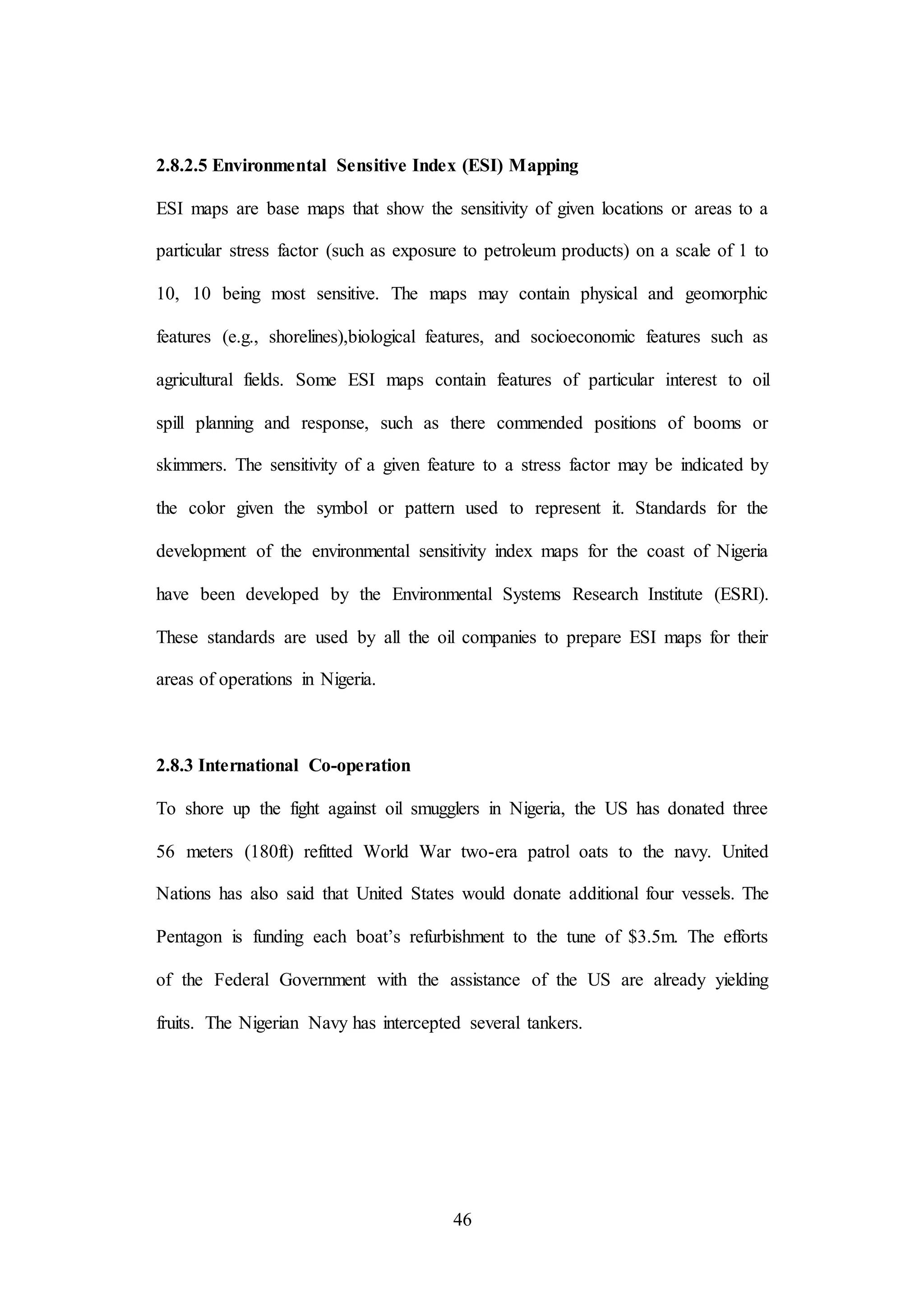



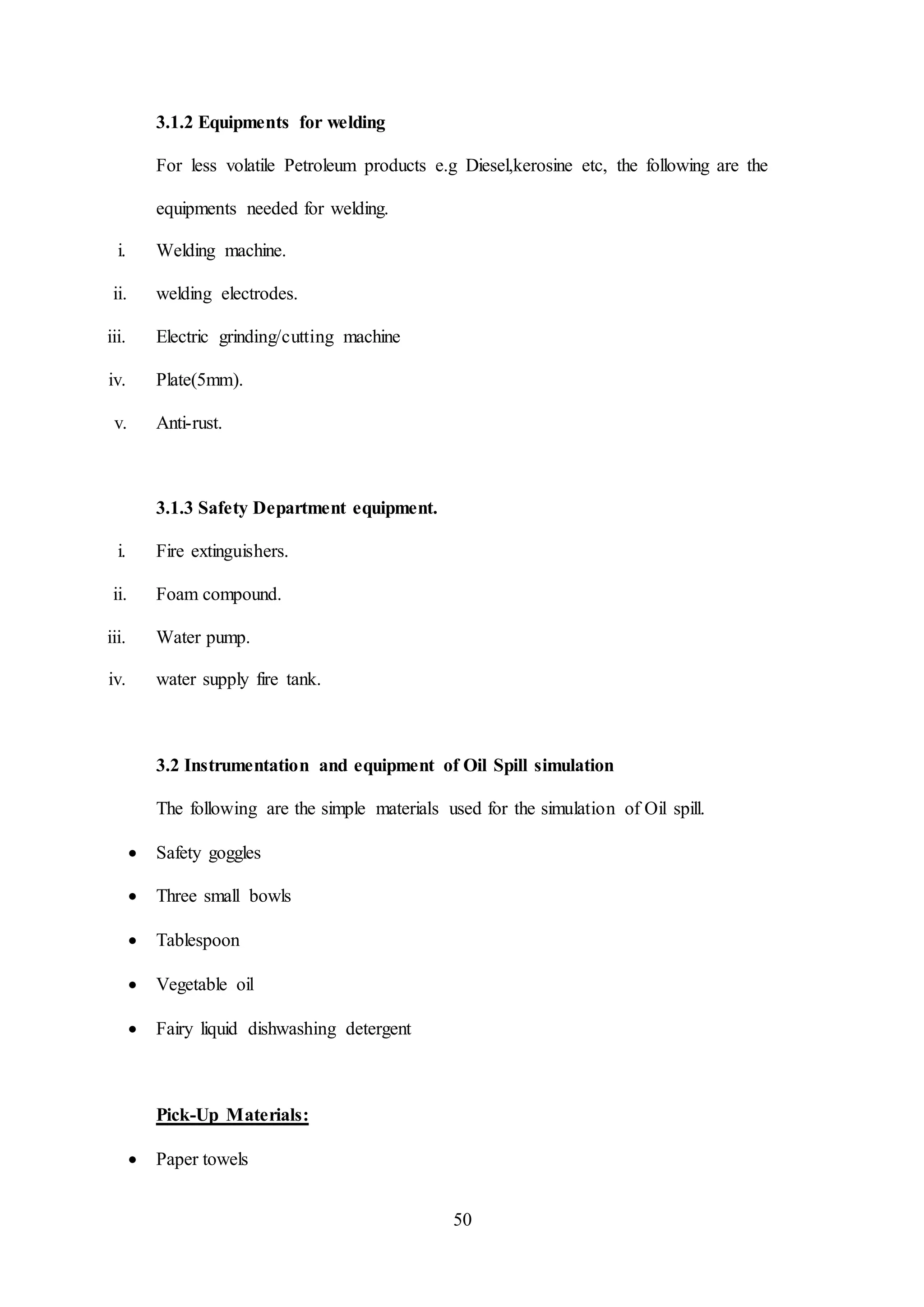
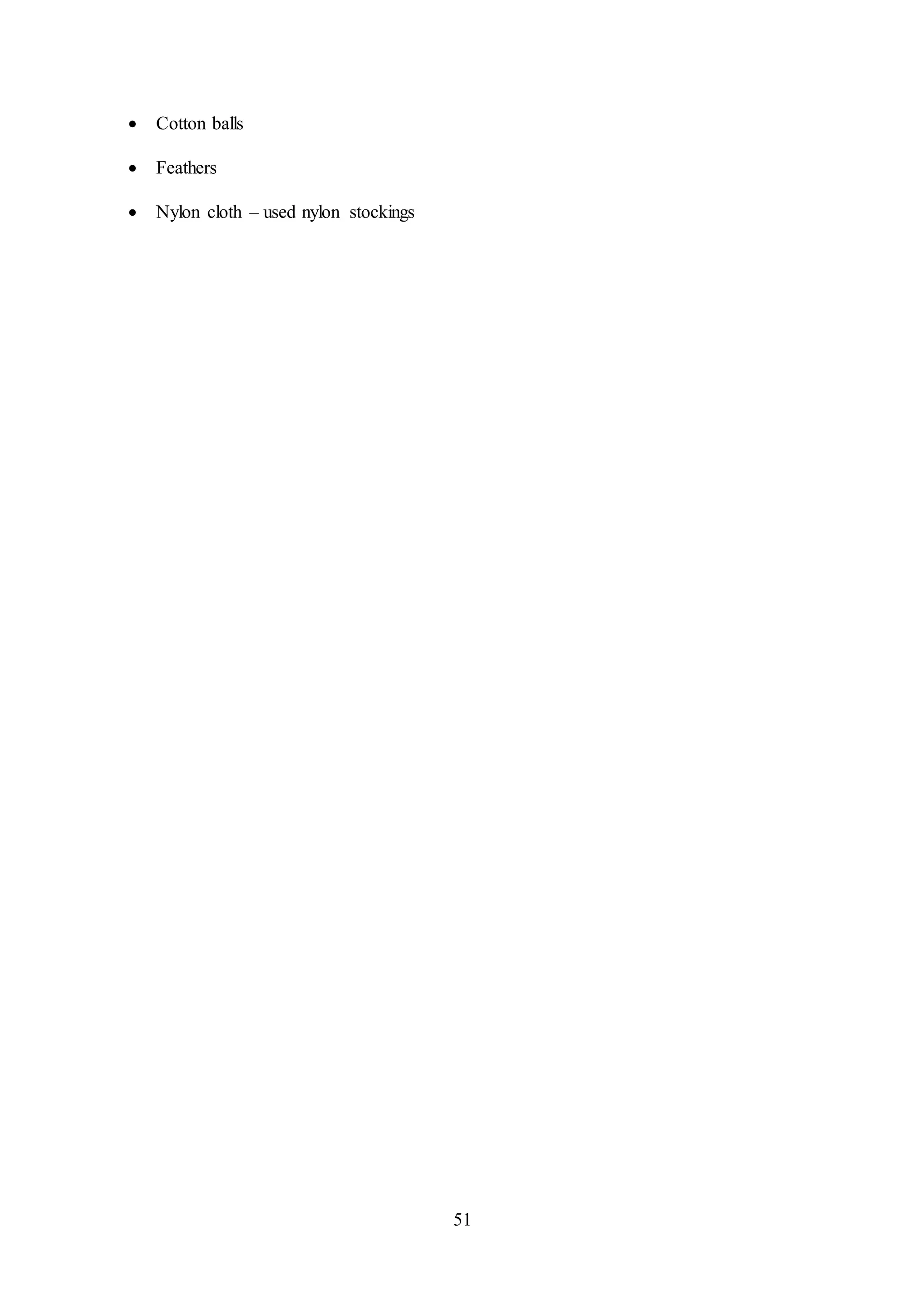




![56
CHAPTER 5
5.0 RESULTS
Table 5.1 Records of Petroleum Pipelines Vandalism in Pipelines Product and
Marketing Company (P.P.M.C), Zaria Pump Station [43]
DATES
OF
REPORT
AXIS DISTANCE
(Km)
MODE OF
ACTIVITY
6TH May
2010
Zaria/
Kano
96/97 Vandalization.
10th May
2010
Zaria/
Kano
91/98 Vandalization.
17th May
2010
Zaria/
kad.
72/73 Vandalization.
17th May
2010
Zaria/
Kano
95.6 Vandalization.
18th May
2010
Zaria/
Kano
95.6 Suspicious
tempering.
24th May
2010
Zaria/
Kad.
68/69 Vandalization.
7th June
2010
Zaria/
Kad.
64/65 Vandalization.
6th July
2010
Zaria/
Kad.
57 Vandalization.](https://image.slidesharecdn.com/genesisi-170318180417/75/Genesis-i-t-project-work-66-2048.jpg)
